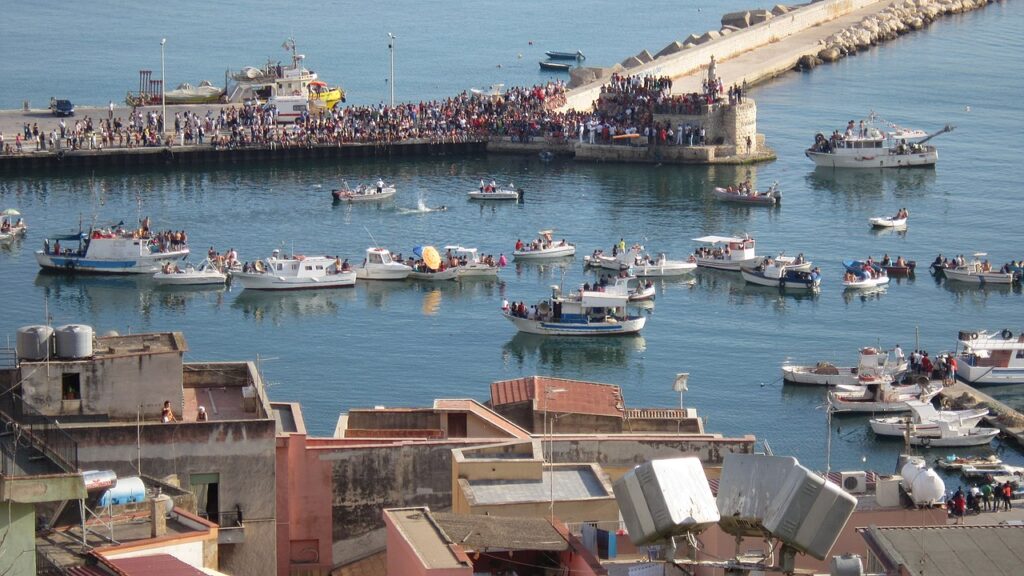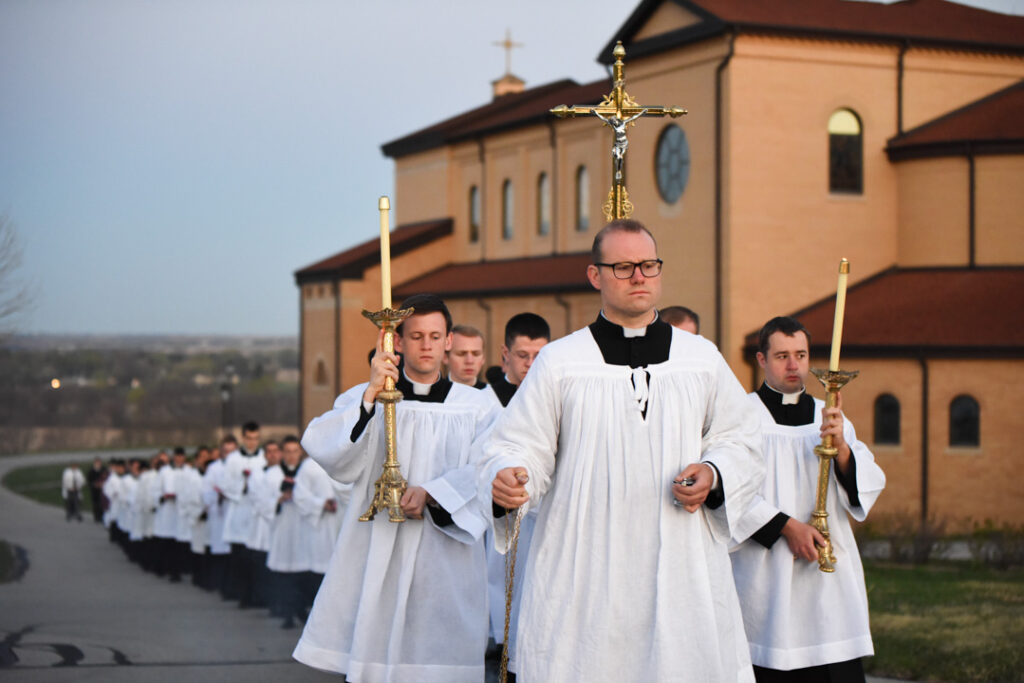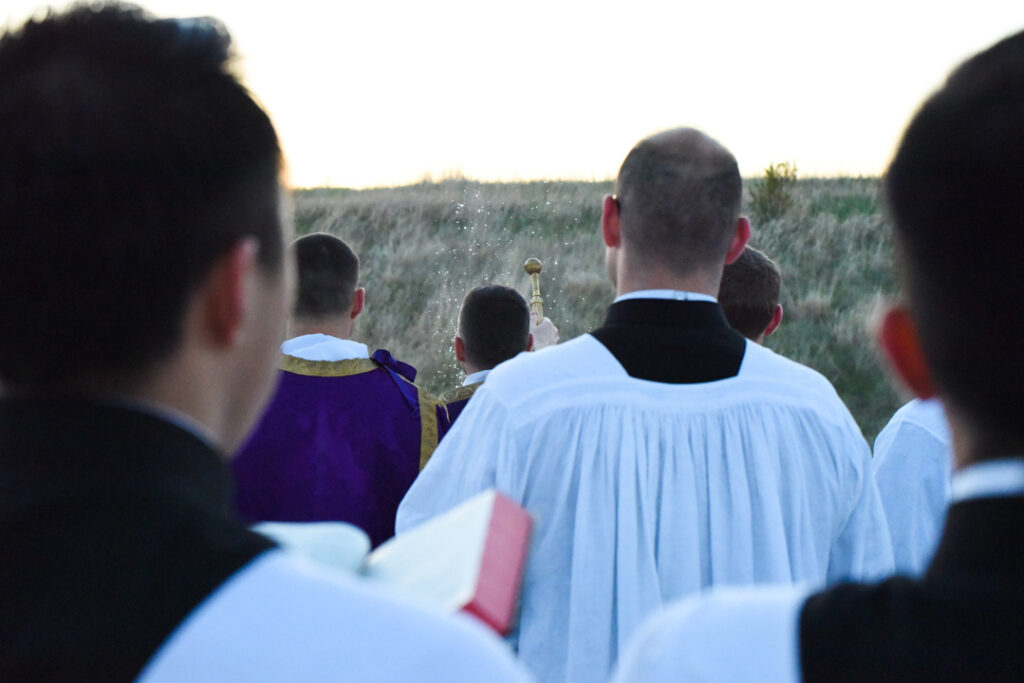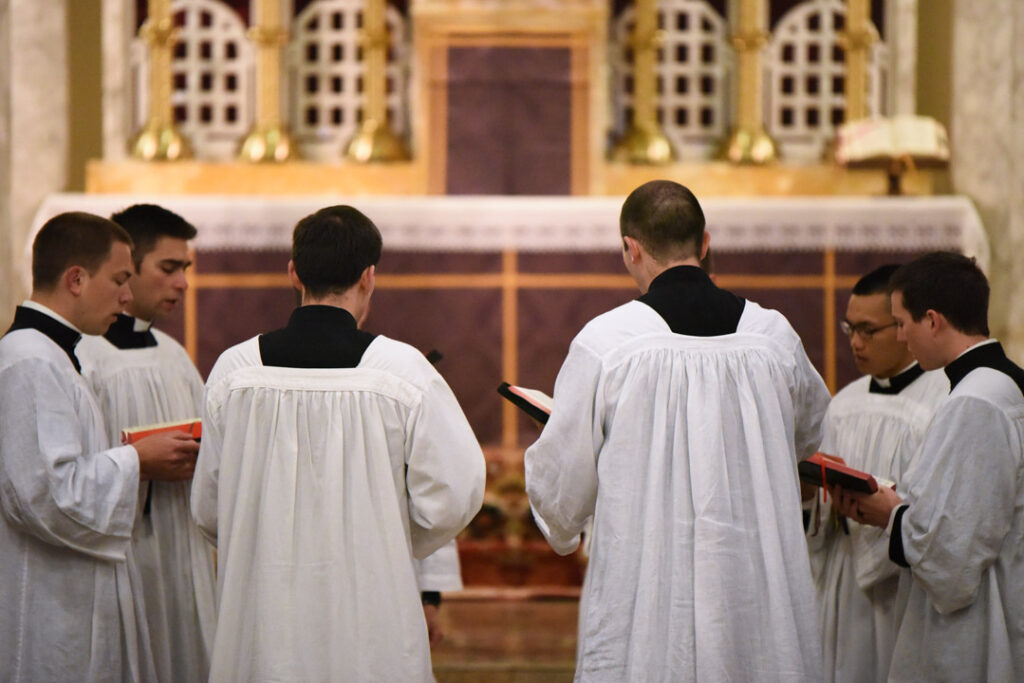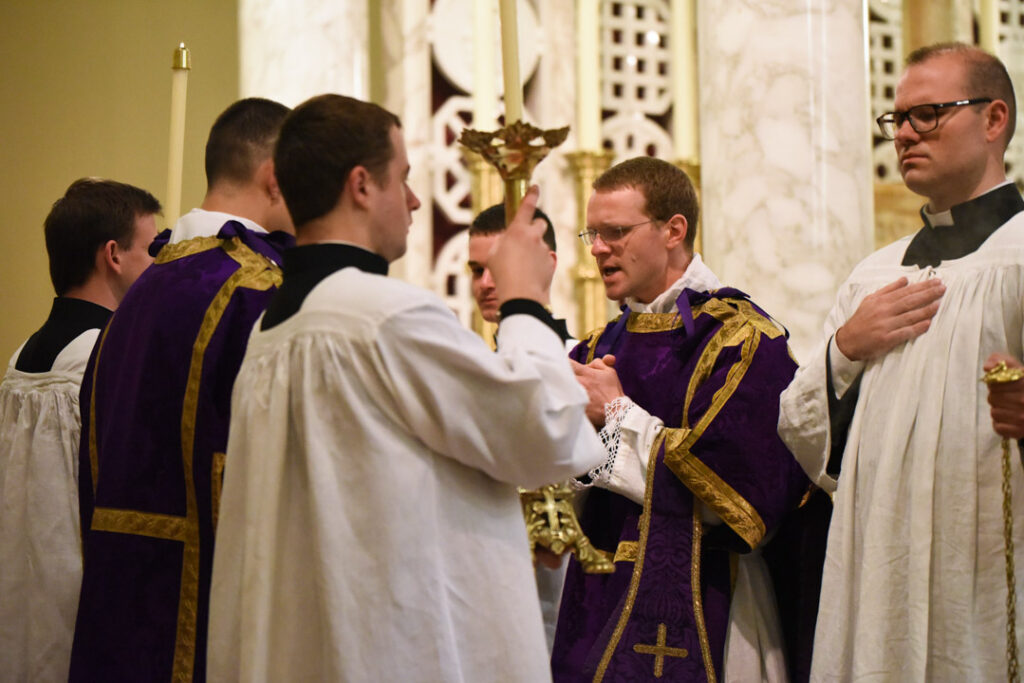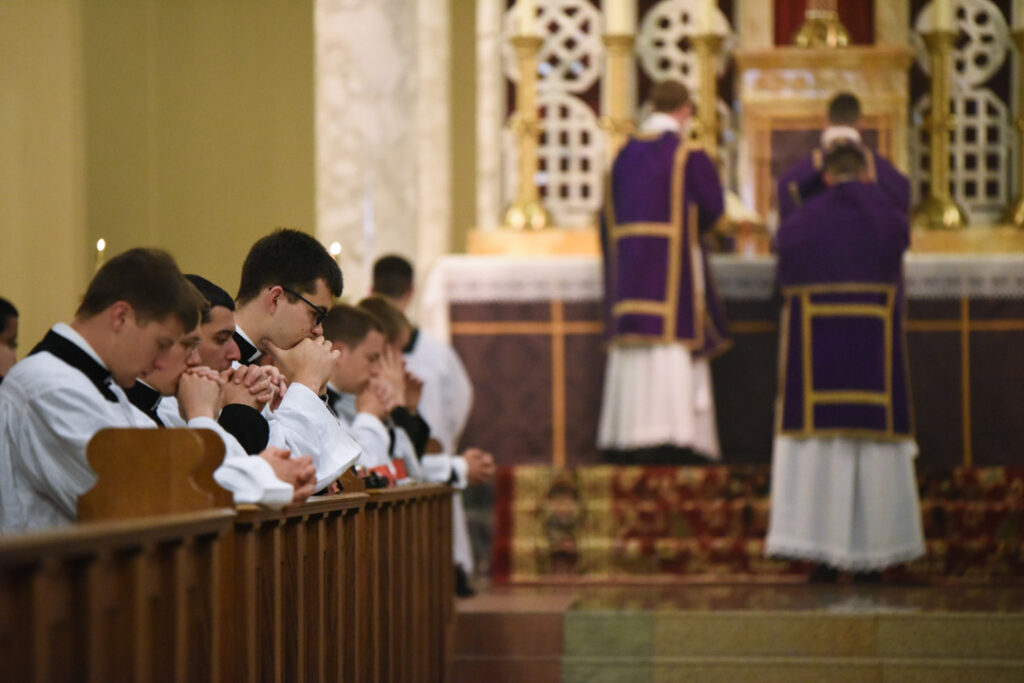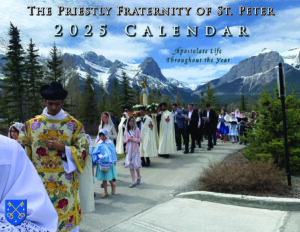Traditions of Ss. Peter and Paul
There are a vast number of ways for individuals and families to keep the feast of Ss. Peter and Paul, or “St. Peter’s Day”, as it has been colloquially known in English.
The first thing worth knowing for the modern Catholic is that, in most countries, it is still listed as a general Holy Day of Obligation, as we see in the current 1983 Code of Canon Law:
Can. 1246. §1. Sunday, on which by apostolic tradition the paschal mystery is celebrated, must be observed in the universal Church as the primordial holy day of obligation. The following days must also be observed: the Nativity of our Lord Jesus Christ, the Epiphany, the Ascension, the Body and Blood of Christ, Holy Mary the Mother of God, her Immaculate Conception, her Assumption, Saint Joseph, Saint Peter and Saint Paul the Apostles, and All Saints. §2. With the prior approval of the Apostolic See, however, the conference of bishops can suppress some of the holy days of obligation or transfer them to a Sunday.
As indicated in the last sentence, however, bishops’ conferences can modify this list with approval, and that is indeed why this holy day is no longer of obligation in the United States and Canada. Nonetheless, Holy Mass has always been an important part of the day’s tradition, and many of the customs mentioned below take place at the parish church or after Mass on that day.
Below I have collected some traditions surrounding the feast of Ss. Peter and Paul, drawn from the immemorial liturgy of the Roman Rite itself as well as the folk customs of Rome and the wider world of Latin Catholicism. (Naturally, as the day is such an important one throughout all of Christendom, the various Eastern Rites have their own venerable traditions.)
Fasting on the Vigil
As you will see in your daily Missals, June 28th is the vigil of Ss. Peter and Paul. Like other vigils, it is a penitential day liturgically: the vestments are violet, and the Gloria is suppressed. It used to be a required day of fasting as well, but not for over a century in Canada and the Commonwealth nations, and not since 1842 within the United States.
Although fasting on the vigil is not binding on Catholics any longer, the faithful may keep it voluntarily if they wish. The only caveat is that one does not keep any fast on years where the vigil falls on a Sunday. Traditionally, churches would either simply skip fasting that year altogether, or fast on the Saturday before the vigil: June 27th.
Customs of the Feast Day
In antiquity the Pope on this day led a pilgrimage accompanied by the Roman faithful and anchored by two pontifical Masses– one at the Vatican, and then one at St. Paul’s Outside the Walls. But the long distance between them proved burdensome, so eventually St. Paul was given his own feast on June 30th.
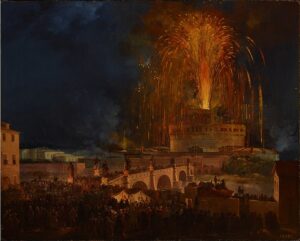 La Girandola–“the Pinwheel”–is an elaborate fireworks show at Castel Saint’Angelo to the east of the Vatican, along the Tiber River. Tradition ascribes the show to the artist Michelangelo, although the celebration of saints’ days with fireworks seems to have been rather common in his day. Though suspended in 1886, it has been revived in recent years. Another old custom within the Vatican is to dress the statue of St. Peter in solemn papal vestments on the evening of the vigil, June 28th.
La Girandola–“the Pinwheel”–is an elaborate fireworks show at Castel Saint’Angelo to the east of the Vatican, along the Tiber River. Tradition ascribes the show to the artist Michelangelo, although the celebration of saints’ days with fireworks seems to have been rather common in his day. Though suspended in 1886, it has been revived in recent years. Another old custom within the Vatican is to dress the statue of St. Peter in solemn papal vestments on the evening of the vigil, June 28th.
Another Roman custom is the Infiorata–“flowering”—which was born on the 29th of June in 1625, when the head florist of the Vatican Benedetto Drei decorated St. Peter’s basilica with beautiful mosaic flower carpets. Though the custom was shortly after abandoned for almost four centuries, nearby places like the Alban Hills kept the tradition alive until it was finally restored to Rome in 2011. The artwork for the infiorata is elaborately planned and conceived, but for the feast families can easily do scaled-down versions at home. The general rule is to use the most natural materials possible–not only various colored flowers but also herbs, soil, coffee grounds, beans, etc. Begin by sketching out a drawing in chalk on the floor, then sprinkling coffee grounds or soil over the chalk to create the outlines of the drawing. Then fill each section with flowers or other materials as appropriate. Then, during a procession or at the close of festivities, the children are encouraged to walk or run across the images and erase them.
Nautical celebrations are very popular on this day. In many coastal communities around the world, from South America all the way to Gloucester, Massachusetts, June 29th is a day not only for carnivals, parades, and processions but also boat decoration and boat races. In Nice, on the French Riviera, the guild of fishermen has a custom to burn the boat of the poorest one among them, and replace it with a new one.
Landlocked regions may not be as able to keep maritime traditions, but they nevertheless have their own customs. In Hungary the feast day marks the beginning of the wheat harvest–with just a symbolic sweep of the scythe to respect the holiday from servile work. Hungarians bring grain, bread, and woven straw decorations to their churches to be blessed, and harvest wreaths were made and displayed until Christmas. In Alpine countries there was a tradition to kneel beneath a garden tree and recite the Angelus at the ringing of the Angelus bell, in order to receive the Papal blessing carried by angels throughout the world. Austria and Bavaria have a tradition of the Petersfeuer bonfire, perhaps an extension of the fires that traditionally accompanied the feast of St. John the Baptist on June 23rd.
The Foods of the Feast
Because St. Peter was originally a fisherman, seafood was prominent in the day’s cuisine.

There are a few species that were given the popular name of “St. Peter’s fish”. One is the John Dory (Zeus faber) of the Mediterranean Sea and the oceans of the Eastern Hemisphere; its unattractive appearance belies its excellent taste (see this recipe from Buon Appetito, Your Holiness: The Secrets of the Papal Table). It has a prominent round dark spot on its flank like a coin; so legend attached it to Christ’s miracle of the coin in the fish’s mouth, from Matthew 17:27.
Several other species in the Holy Land are called “St. Peter’s fish.” These are the Mango tilapia or Galilean St. Peter’s fish (Sarotherodon galilaeus), the common St. Peter’s fish (Tilapia zilli), and the Jordan St. Peter’s fish (Oreochromis aureus). The Galilean species was legendarily the fish multiplied in the Miracle of Loaves and Fishes; and these local Galilean recipes will enable you to treat the family to a taste of Peter’s home region.
Finally, when in 1868 the Trappists took over the Tre Fontane Abbey at the site of St. Paul’s martyrdom, they brought with them a recipe for chocolate that quickly earned them fame in the city. Since then, Romans have made it a habit of visiting them early on the morning of the feast and enjoying rosette rolls and hot chocolate amid the quiet peacefulness of the abbey’s eucalyptus trees. That’s right–having chocolate on the feast of Ss. Peter and Paul is a very Roman way to celebrate this very Roman feast!
Celebrating the Octave

The most important Catholic feast days were traditionally not over and done with in one day, but extended over a whole week of celebration. Ss. Peter and Paul enjoyed a common octave all the way up to 1955, when it was suppressed by Pius XII. The octave is therefore missing from missals printed after that day, although if you happen to have a pre-1955 Missal such as Lasance’s New Roman Missal, you will still find it listed.
Nothing prevents the faithful from still keeping the octave privately as a pious devotion. The simplest way to do that is to pray the collects of the Masses. On June 29th the prayer is as follows:
O God, who hast consecrated this day to the martyrdom of Thine apostles Peter and Paul, grant to Thy Church in all things to follow their teaching by whom it received the right ordering of religion in the beginning.
The next day, June 30th, is the feast of St. Paul, and both the pre-1955 and 1962 Missals have special collects:
O God, Who didst teach the multitude of the nations by the preaching of the blessed Apostle, Paul, grant us, we beseech Thee, that, venerating his natal day, we may experience the benefits of his intercession with Thee.
O God, Who, in conferring upon blessed Peter, Thine apostle, the keys of the heavenly kingdom, didst commit to him the priestly power of binding and loosing, grant that, by the help of his intercession, we may be delivered from the bonds of our sin.
On each day of the octave from July 1st to July 5th, the collect of the feast is said:
O God, who hast consecrated this day to the martyrdom of Thine apostles Peter and Paul, grant to Thy Church in all things to follow their teaching by whom it received the right ordering of religion in the beginning.
Finally, there is a unique collect for July 6th, the octave-day:
O God, whose right hand raised up blessed Peter, when he walked upon the waves, that he might not sink, and delivered his fellow-apostle Paul, thrice shipwrecked, from the depths of the sea, graciously hear us, and grant that, by the merits of them both, we may reach the glory of eternity.
Alternatively, the following commemoration can be made on each day of the octave from June 29th to July 6th:
Commemoration of Ss. Peter and Paul
Antiphon. Peter, the Apostle, and Paul, the Doctor of the nations, these have taught us Thy law, O Lord.
Verse. Thou shalt make them princes over all the earth.
Response. They shall remember Thy name, O Lord.
Let us pray.
O God, Who hast made holy this day by the martyrdom of Thine apostles, Peter and Paul, grant unto Thy Church that as through them she first received the faith, so may she in all things follow their precepts. Through Christ our Lord, Amen.
Celebrating Beyond the Octave
In a previous article I noted that, in Carolingian times, the long Post-Pentecost season was divided into various subseasons, and in this scheme, the feast of Ss. Peter and Paul was so important that it marked a transition from one subseason to another.
From the Pentecost octave to June 29th were the “Sundays of Pentecost” proper. After the feast was the Sunday post Natalem Apostolorum–“after the Birthday of the Apostles”. This last Sunday was followed by a sequence of six or seven numbered “Sundays after the Octave of the Apostles”, that filled up the time to the feast of St. Lawrence on August 10th.
This was a characteristically Roman arrangement. The Ambrosian rite of Milan did things quite differently, instead transitioning from the “Sundays after Pentecost” to the “Sundays after the Decollation” after the feast of St. John the Baptist on August 29th.
So, at least historically, the Roman liturgical books had a named liturgical subseason dedicated to Saints Peter and Paul that ran from the feast on June 29th to the vigil of St. Lawrence on August 9th. The name has since disappeared, so you won’t necessarily find it in your missals. But the evidence of it can still be seen in the Sunday Mass readings.
All of the Epistles of the 3rd to the 8th Sundays after Pentecost–which is roughly about the timeframe within which June 29th can fall–come from either the First Epistle of Peter or Paul’s Epistle to the Romans. And the readings for the 4th Sunday are Paul’s Epistle to the Romans prefiguring his martyrdom and the Gospel of Luke with St. Peter’s miraculous draught of fishes. This Petrine Gospel seems to be a clear case of the Sanctoral calendar making its mark on the Sunday calendar; as Fr. Francis X. Weiser points out, this also occurred with other highly venerated Roman martyrs like St. Lawrence and Ss. Cosmas and Damian.
As a way of restoring this “Petrine” subseason, families may wish to decorate their homes with extra images of the Apostles and their symbols (e.g. keys and swords). Having the children make and display scale model churches–particularly St. Peter’s in Rome–out of building toys fits the spirit of the season quite well. An important theme of the Post-Pentecost season is the growth and progress of the Church throughout the ages. So once we have already celebrated Peter and Paul’s martyrdom and founding of the Church over the octave, it is good to spend a little while meditating on how their Apostolic work helped build the institution of the Papacy, bring the Gospel to all the Gentile nations, and benefit the entire Church.
June 27, 2023

The New Founders of Rome, Part 1: the Feast
by Claudio Salvucci
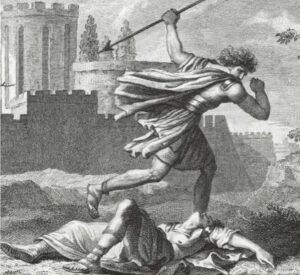 According to legend, the city of Rome was founded on April 21st, 753 B.C. by a pair of twins named Romulus and Remus. When Remus made sport of Romulus’s still rudimentary defenses and leapt over them, he was killed for the slight, and so it was Romulus who gave his name to the city, became its first king, and established so many of its civic institutions, including its calendar and its religion.
According to legend, the city of Rome was founded on April 21st, 753 B.C. by a pair of twins named Romulus and Remus. When Remus made sport of Romulus’s still rudimentary defenses and leapt over them, he was killed for the slight, and so it was Romulus who gave his name to the city, became its first king, and established so many of its civic institutions, including its calendar and its religion.
As Ovid tells the story, Mars then prevailed upon Jupiter to deify Romulus:
“…he caught up Romulus, son of Ilia, as he was dealing royal justice to his people. The king’s mortal body dissolved in the clear atmosphere, like the lead bullet, that often melts in mid-air, hurled by the broad thong of a catapult. Now he has beauty of form, and he is Quirinus, clothed in ceremonial robes, such a form as is worthier of the sacred high seats of the gods.”
From then on, under the new name Quirinus, Romulus would be worshipped as a deity by the Romans. And April 21st, the putative day of the founding, continued to be celebrated throughout Roman history as the Natalis Urbis, the Birthday of the City. In A.D. 248, we hear that the reigning Emperor Philip the Arab celebrated the 1000th year anniversary of the city with “games of all kinds”.
But this was, perhaps, the last great celebration of the sort.
In the post-Constantinian era, as Christianity increasingly rivaled and then finally supplanted paganism, the character of Romulus came under increasing scrutiny. The Church Fathers repeatedly presented him as a man not worthy of emulation, much less deification, as we see in Augustine (City of God, 22:6), Tertullian, (De Spectaculis 5). Minucius Felix (Octavius, 25), and Lactantius (Divine Institutes, 20).
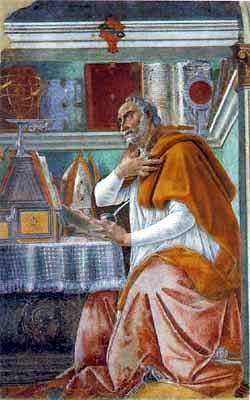
Augustine, as usual, is the most devastating in his rhetoric–not because he was the most polemical but because as a long-time admirer of Roman legends himself, he understood their flaws at a very deep level. With calm precision, and in his inimitable way, he contrasted the religion of Christ with the religion of Romulus:
For, not to mention the multitude of very striking miracles which proved that Christ is God, there were also divine prophecies heralding Him, prophecies most worthy of belief, which being already accomplished, we have not, like the fathers, to wait for their verification. Of Romulus, on the other hand, and of his building Rome and reigning in it, we read or hear the narrative of what did take place, not prediction which beforehand said that such things should be. And so far as his reception among the gods is concerned, history only records that this was believed, and does not state it as a fact; for no miraculous signs testified to the truth of this.
Christ was a more fitting deity than Romulus not only because He did the things that only a deity can do, but also because He was the fulfillment of a prophecy that long antedated Him. Augustine goes on to take apart the legend of Romulus piecemeal:
For as to that wolf which is said to have nursed the twin-brothers, and which is considered a great marvel, how does this prove him to have been divine? For even supposing that this nurse was a real wolf and not a mere courtesan, yet she nursed both brothers, and Remus is not reckoned a god.
Besides, what was there to hinder any one from asserting that Romulus or Hercules, or any such man, was a god? Or who would rather choose to die than profess belief in his divinity? And did a single nation worship Romulus among its gods, unless it were forced through fear of the Roman name?
He concludes his argument as follows:
And thus the dread of some slight indignation, which it was supposed, perhaps groundlessly, might exist in the minds of the Romans, constrained some states who were subject to Rome to worship Romulus as a god; whereas the dread, not of a slight mental shock, but of severe and various punishments, and of death itself, the most formidable of all, could not prevent an immense multitude of martyrs throughout the world from not merely worshipping but also confessing Christ as God.
In the late stages of an increasingly decadent Roman Empire, the Christian martyrs’ courage stood in stark opposition to the conduct of the age. Even though they served a different deity, the martyrs recalled by their courage a bygone Rome, appealing to those citizens who lamented the dissolution of the old Roman pietas that was in very short supply among their contemporaries.
Thus was the mind of pagan Rome opened to the revelation of Christ. And through her most famous martyrs of all, the Eternal City would inherit a new set of founding fathers to replace the ones they lost.
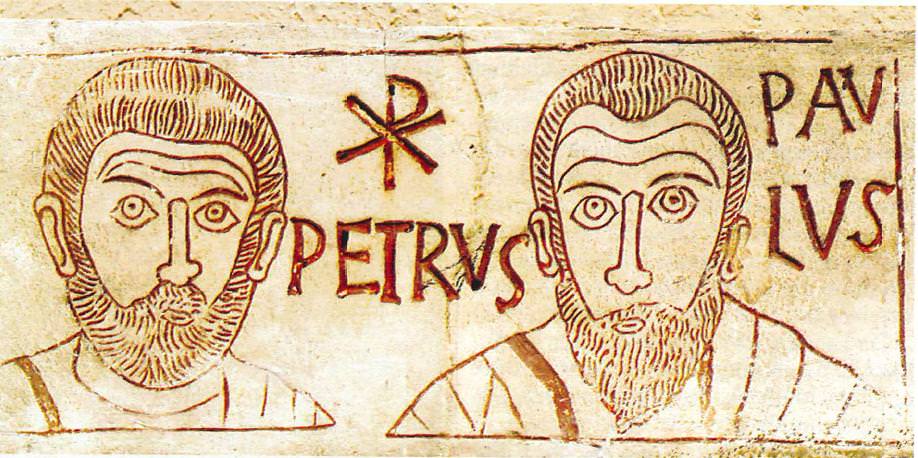
The New Founders
The Apostles Peter and Paul–a Galilean fisherman and a scholarly Pharisee–might be thought extremely unlikely candidates to replace Romulus and Remus. They were not even brothers in flesh, although they were brothers in Christ.
Yet they were very well situated for a Christian recalibration of the founding myth. As Pope St. Leo the Great said in his homily for their feast:
The whole world, dearly-beloved, does indeed take part in all holy anniversaries, and loyalty to the one Faith demands that whatever is recorded as done for all men’s salvation should be everywhere celebrated with common rejoicings. But, besides that reverence which today’s festival has gained from all the world, it is to be honoured with special and peculiar exultation in our city, that there may be a predominance of gladness on the day of their martyrdom in the place where the chief of the Apostles met their glorious end.
For these are the men, through whom the light of Christ’s gospel shone on you, O Rome, and through whom you, who was the teacher of error, was made the disciple of Truth. These are your holy Fathers and true shepherds, who gave you claims to be numbered among the heavenly kingdoms, and built you under much better and happier auspices than they, by whose zeal the first foundations of your walls were laid: and of whom the one that gave you your name defiled you with his brother’s blood.
These are they who promoted you to such glory, that being made a holy nation, a chosen people, a priestly and royal state, and the head of the world through the blessed Peter’s holy See you attained a wider sway by the worship of God than by earthly government. For although you were increased by many victories, and extended your rule on land and sea, yet what your toils in war subdued is less than what the peace of Christ has conquered.
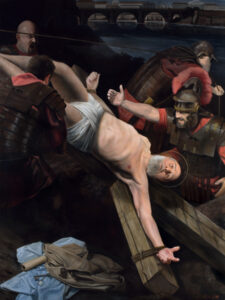
Even though Peter and Paul labored together in Rome, tradition has long maintained that they were martyred separately. The Prince of the Apostles died on the Vatican upon a cross. The Apostle to the Gentiles was beheaded along the Via Laurentina, as he was a citizen and could not be crucified.
One could certainly imagine a liturgical situation where St. Peter had his own feast and St. Paul had another completely separate one–but that is not what we see in the sources. Peter and Paul have been honored together on June 29th from time immemorial.
Dionysius, the Bishop of Corinth around the year 170, says that Peter and Paul “suffered martyrdom at the same time” (as quoted in Eusebius’s History of the Church II.25). But the passage does not offer any specific date. The actual feast day first appears in an ancient collection called the Chronography of 354, which contains a martyrology as well as a catalog of Popes. The first entry of the papal catalog is as follows:
Peter 25 years, 1 month, 9 days. He was in the times of Tiberius Caesar and Gaius and Tiberius Claudius and Nero, from the consulate of Minucius and Longinus [AD 30] to that of Nero and Verus [AD 55]. However he died with Paul on the 3rd day before the kalends of July, the emperor Nero being consul.
In the Depositionis Martyrum, a calendar of martyrs’ feasts in the same collection, the exact same date (the 3rd before the kalends of July) is given for Peter and Paul. Yet it also adds a puzzling note: “[during the] consulship of Tuscus and Bassus”. These two consuls are from A.D. 258, two centuries after Peter died. Some have surmised that the date must refer to a translation of the Apostles’ relics instead of their deaths, though there is also a Bassus who was consul under Nero in A.D. 64, complicating the matter.
As the papal catalog is meant as a historical document, its clear and explicit reference ought to command greater weight than an unclear reference mentioned as an aside in a liturgical calendar. Thus, considered together with the passage from Dionysius, it seems safest for history to side with the papal catalog that June 29th commemorates the actual deaths of Peter and Paul, and not merely a translation of their remains.
Finally, we cannot fail to mention another early tradition that is seen in St. Augustine (Sermo 295, 381), whereby Paul was indeed martyred on the same day as Peter, but not in the same year.
The Old Dates Prefiguring the New
So it was that Rome left off celebrating the date of founding by Romulus and Remus, and began celebrating Peter and Paul’s martyrdoms instead.
And perhaps Almighty God had already been preparing Romans for the transition through the natural course of history; sowing, long before Christ was even born, three seeds of the future Christian revelation into the ancient fabric of Italian paganism.
First, April 21st was not merely the secular date of Rome’s founding. It was also a religious festival called the Parilia, named for Pales, the god of shepherds and livestock, to whom the Romans prayed to keep the flocks fed and protected from diseases and wolves. Romulus and Remus’s association with shepherding was very strong; that was their occupation before they founded Rome, having inherited it from their foster-father, the shepherd Faustulus.
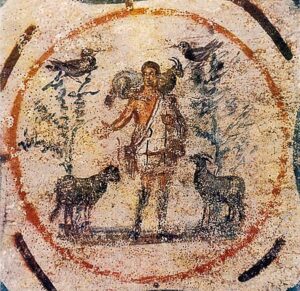
The season of the Parilia took on a deeper Christian meaning in the Roman Liturgy. Good Shepherd Sunday is the 2nd Sunday of Easter, which frequently falls around April 21st. The Epistle of St. Peter is read often in these early weeks of Eastertide, and at this Mass it anticipates the Gospel with the passage: “For you were as sheep going astray: but you are now converted to the shepherd and bishop of your souls.”
Thus, it would have been very natural for Roman Christians to see the Parilia as an anticipation not only of Christ the Good Shepherd but also Peter and his successors, who faithfully served their See with the words of the Risen Christ still resounding in their ears: “feed my lambs, feed my sheep.”
Second, on the Quirinal Hill there stood a temple dedicated to Quirinus/Romulus–said to be one of oldest temples in Rome, going to back to at least 293 B.C. and perhaps even earlier. At this temple was held the festival known as the Quirinalia, which took place annually on February 17th.
Note how close this date is to February 22nd, the second feast of the Chair of St. Peter. Despite its later associations with Antioch, this feast is Roman enough and ancient enough that it appears on the Chronography of 354. Christian Romans thus honored Peter in the very same week that their pagan counterparts honored Romulus, which no doubt strengthened the associations between the two.
Third is perhaps the most striking coincidence.
In 49 B.C., civil war was breaking out between Caesar and Pompey, and inauspicious portents like earthquakes and eclipses were alarming the Roman populace. The temple of Quirinus was consumed by fire. Lightning damaged a sceptre of Jupiter and a shield and helmet of Mars on the Capitol–the symbols of power of the very same gods who were said to have deified Romulus. To the Romans, it would have been crystal clear that divine wrath was falling on their city. And in hindsight, it looks rather like it was falling on their gods as well.
The temple of Quirinus was rebuilt and rededicated by Augustus in 16 B.C., and there remains to this day an ancient relief showing its restored pediment, with Romulus and Remus taking the auspices (image at right). This rededication occurred not during the traditional Quirinalia but in summer, after the Secular Games and just before Augustus left the city for Gaul. From Ovid we learn the exact date: the third day before the kalends of July.
Some sixteen years before the birth of Christ, roughly around the time that the Virgin Mary would likely have been born, the Romans began to celebrate a feast of their founders . . . on the 29th of June.
And they have been doing it ever since.
June 21, 2023

Ss. Peter and Paul artist Eric Armusik
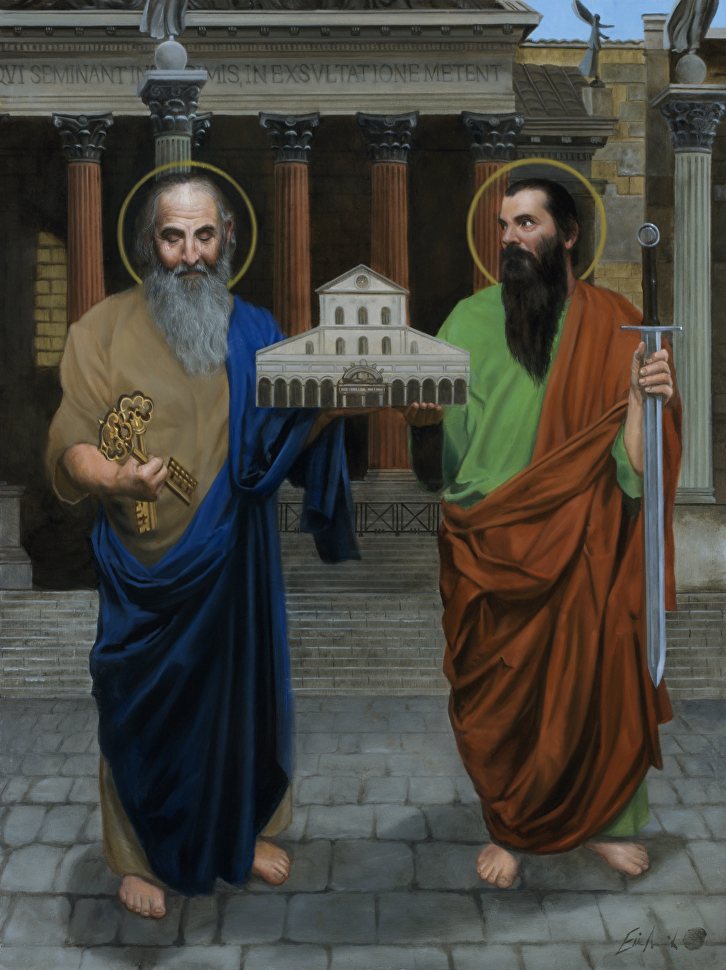
This year, we wanted to do a little something different for our celebration of our patronal feast. Instead of simply using a painting from centuries ago–as beautiful as they admittedly are–we commissioned a brand-new painting from Pennsylvania artist Eric Armusik.
Armusik is a classical figurative artist who has taken up the techniques and subjects of the Old Masters and rejected the modernist aesthetic of the last century. He is also a devoted husband and father of three, and a member of our FSSP apostolate St. Stephen of Hungary in Allentown, PA.
“I didn’t have any training going into school,” he admitted. “I never painted until I was 20 years old. College gave me art history, and I quickly saw what I loved.”
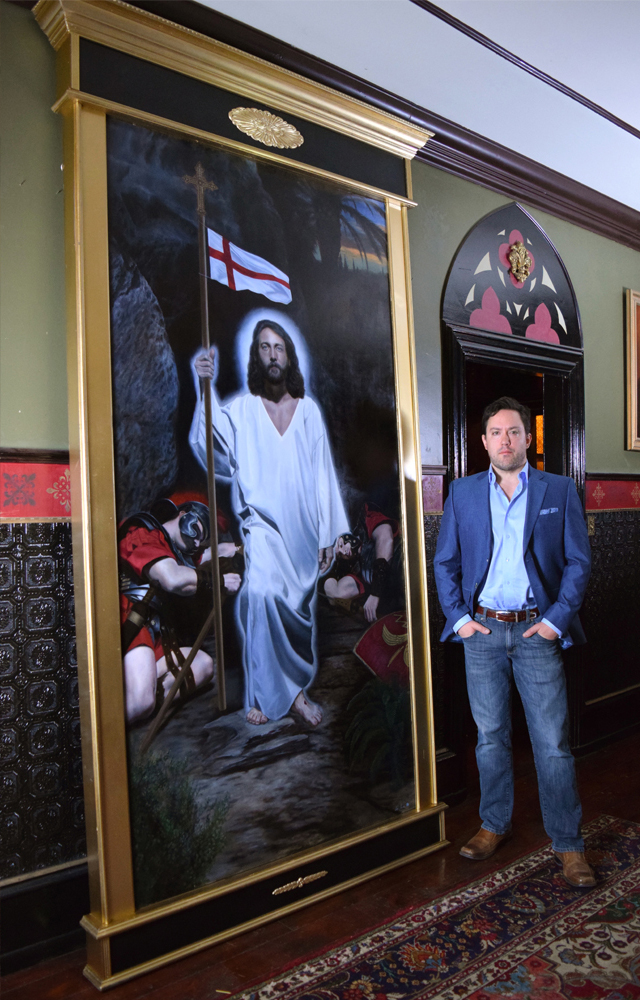
Armusik grew up Catholic in Northeastern Pennsylvania, amidst some beautiful churches in his hometown. He remembers sitting in the pews praying (and daydreaming) but also staring at the artwork and thinking: “this is what I want to do. And after a semester in Italy, it started making sense to me why art appealed to me.”
But his interest in sacred art didn’t translate well to the tenets of modernism, and professors and fellow artists tried to dissuade him from following his instincts.
“They told me that was passé. I was heartbroken.” Their opinions seemed confirmed during a group critique in art school, in which he “felt destroyed.”
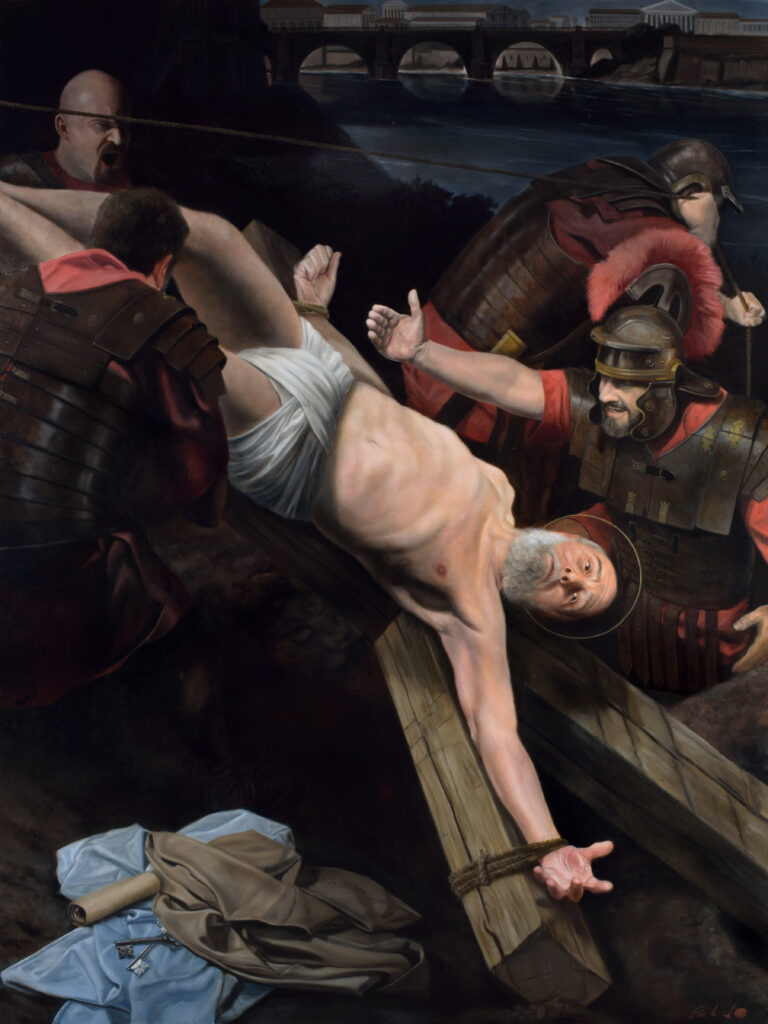
Discouraged, Armusik tried to acquiesce to the prevailing culture and paint in more modernist style, albeit tempered with some nods to tradition. But it wasn’t what he really wanted, and he wasn’t happy with the results. It was his wife Rebekah who put him back on the right track with one simple statement:
“If I could paint the way you can paint, I wouldn’t paint that garbage.”
From then on, he would be unapologetic in his embrace of the past. And to this day, she is one of the only people whose opinion he trusts.
But taking an alternative path within the art world wasn’t easy, and there was little help along the way. There were many techniques he had to learn himself: “Art instructors today might not cover 20% of what the old masters did.” And there was an aesthetic readjustment that was necessary as well: “I had to rearrange my brain and start trusting my eyes again.”
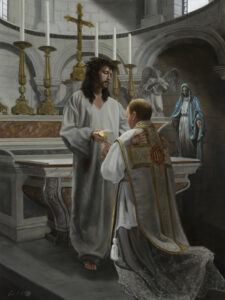
Luckily, his faith was there to provide support.
The Armusiks were married in the Latin Mass, but spent the first 10 years of their marriage church shopping: “we craved something reverent.” One day they stumbled on the website for St. Stephen’s in Allentown.
Rediscovering sacred tradition gave a new vitality to his longstanding Catholic faith: “The wires were laid down already–it was just turning on the power.”
That faith continues to inform and deepen his work, as religious work continues to come in from clients. “I feel blessed to be able to do that kind of work, and grateful for every opportunity to do so.”
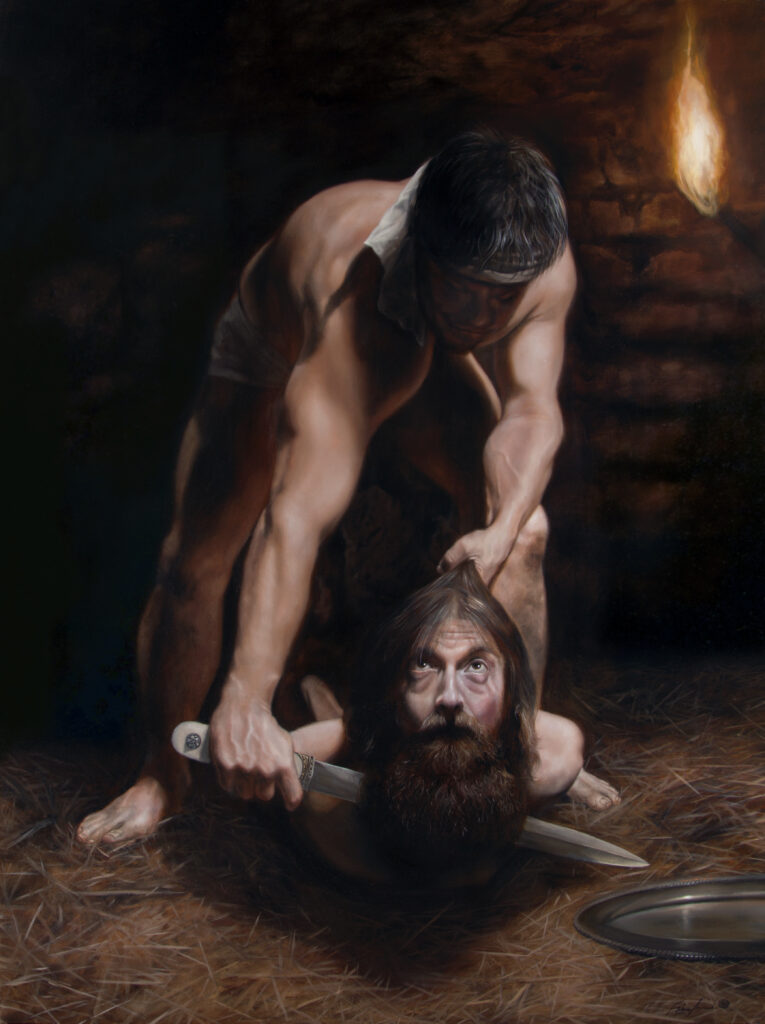
In terms of style, Armusik says he owes much to the Italian artists of the Baroque, particularly Caravaggio’s use of light. In Italy, he had studied Caravaggio intensely, viewing 12 of his pieces in person, some for hours at a time. He was particularly moved by the martyrdom of St. Peter. “It changed my life”
He sees light as “the presence of God in all my work.” He also particularly admires the realism that Caravaggio brought to art, something that wasn’t always appreciated by contemporaries, who expected saints to be portrayed in an idealized manner.
“Caravaggio worked from people, not drawings … That’s why I work with everyday people, because I want to see everyday people in those situations.”

Armusik’s most ambitious project to date is a massive series on Dante’s Divine Comedy. To respect the original subject matter as much as possible, he works with Dante scholar Dr. Christopher Kleinhenz, Professor Emeritus of the University of Wisconsin-Madison.

And besides all the other ecclesiastical art and portraiture which he features on his website, a good part of his time is being a mentor and teacher to the next generation. Art instruction is a big part of that, of course. But he is also very dedicated to passing on what he knows beyond the paintbrush, and teaching artists to be successful in their career:
“Art is an entrepreneurial position. The business side is more important the art side, and a half-talented person who is good at marketing is going to succeed where a more talented person won’t.”
This might seem like surprising advice from an artist, but he wants artists to succeed at doing what they love best.
Part of Armusik’s success involves engaging people where they are at in the digital world.
Painting the details of the hair and beard for St. Peter for my commission. Oil on panel 18 x 24”
👉 See more of my artwork at https://t.co/g1vjYgmc0n#howtopaint #paintinghair #paintingportraits #CatholicTwitter #catholic #paintingpeople #realism #art #paintingtips #painting pic.twitter.com/gat1VhHezR
— Eric Armusik – Classical Figurative Artist (@armusik) April 26, 2023
“I put my art out there on social media for everybody. And 97% of it is positive–only a small number of people who are critical.” A Last Supper drawing he happened to share on Tiktok–not a platform usually associated with fine art–received a surprising 380,000 views. “it’s great to see people who aren’t even of the faith commenting and appreciating. Catholic art is truly beautiful.”
My finished commission of Sts. Peter and Paul, oil on panel 18 x 24”.
🙏✝️see more of my artwork at https://t.co/g1vjYgmJPV#CatholicTwitter #Catholics #catholic #artwork #painting #artist #ericarmusik pic.twitter.com/uwliDXSGap— Eric Armusik – Traditional Artist (@armusik) May 4, 2023
In style, in technique, and even in business, Armusik’s art is a unique blend of the old and the new– techniques going back centuries, and themes going back millenia, and all brought forward into the new digital age of social media.
But driving it all is the very same love that inspired a young man from the industrial Northeast to gaze up in wonder at the sacred images that filled the churches of his hometown:
“The world needs more beauty.”
For more of Eric Armusik’s art and some great advice for young artists, see his website at https://www.ericarmusik.com/. For inquiries or commissions, he can be reached via email at info@ericarmusik.com.
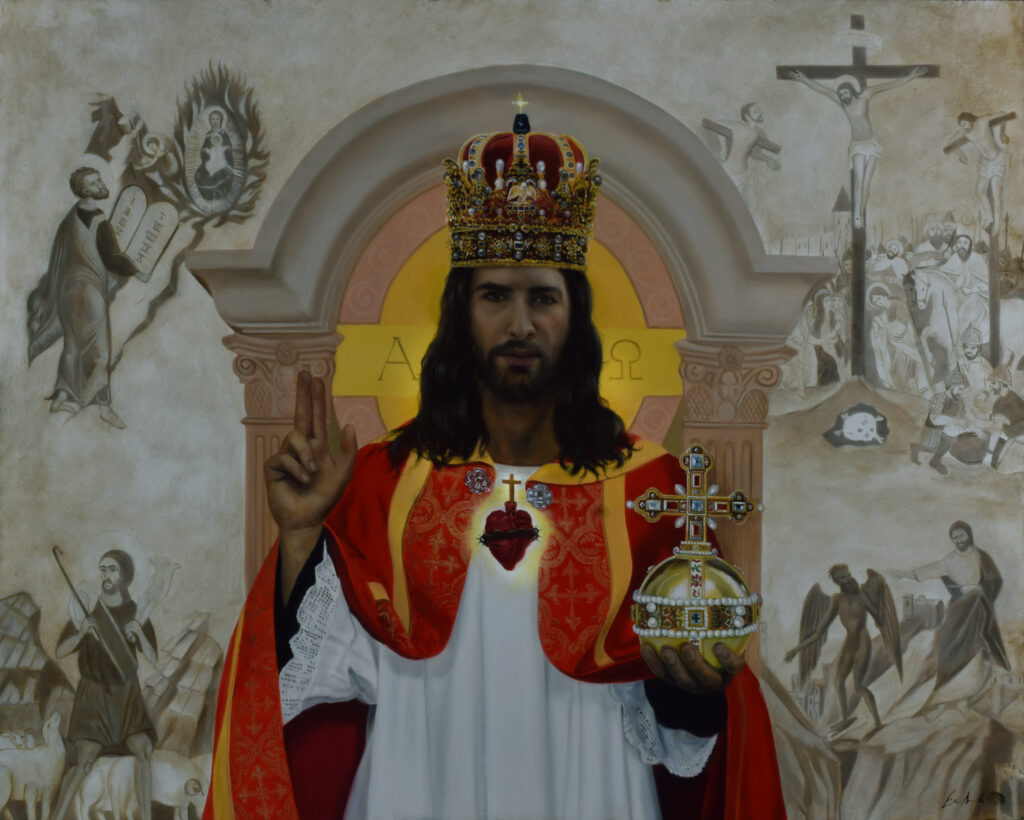
June 16, 2023

Joy that One is Born into the World
By Fr. William Rock, FSSP
It seems that after the two-and-a-half-weeks of Septuagesima, the 40 fasting days of Lent, the 50 days of Easter, and then the Octave of Pentecost and Trinity Sunday, Our Holy Mother, the Church, is not yet ready to leave behind the mysteries she has been meditating upon during those times. She, as it were, turns her gaze backwards and renews, recapitulates, some of the most profound moments of the Easter Cycle, but this time, not with Our Lord’s impending Passion and Death before her, but rather with His glorious Resurrection and Ascension behind her.
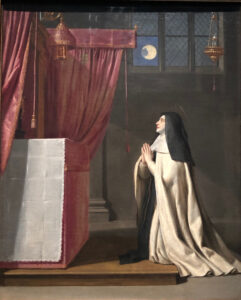
She begins this backwards gaze on the Thursday following Trinity Sunday. A Thursday because here she recapitulates Holy Thursday. Holy Thursday itself commemorates so many things – the Last Supper with the Washing of the Feet, the Institution of the Sacrifice and the Priesthood of the New Law, the betrayal of Judas, Our Lord’s Agony and Capture in the Garden. It was God Himself, in a vision to St. Juliana, Who established which of the aspects of Holy Thursday was to be recapitulated.1 On the Thursday of Corpus Christi, then, the Church, through the lens of the Resurrection and Ascension, places her focus on the Holy Eucharist, one of the themes of Holy Thursday, and all that It means to her. Churches resound with the joyful chants and hymns of this feast, especially those which accompany the Eucharistic Procession where the Blessed Sacrament, no longer hidden under a veil as on Holy Thursday, is held aloft in triumph for all to see. But a one-day celebration could not satisfy the Church’s desire or exhaust the loving devotion she wished to lavish upon this great gift. As such, when the feast of Corpus Christi was instituted in 1264, it was instituted with an octave.2
This Octave having run from a Thursday to a Thursday, the Church finds herself on Friday. How could this not bring to her mind that Friday which followed Holy Thursday, Good Friday? But this Friday is not shrouded in sorrow as Good Friday was, but rather, now that He is Risen, it is vested in joy and celebration. Just as with the celebration of Corpus Christi, it was God Himself Who directed what would be the focus of the devotion of this recapitulated Good Friday. According to St. Margaret Mary Alacoque, Our Lord asked that a Feast of the Sacred Heart, the Heart which was pierced on Good Friday, be celebrated on the Friday following the Octave of Corpus Christi.3 Established in 1856, the Feast of the Sacred Heart was extended with an octave in 1928, allowing the Church to tarry in her sentiments and devotion here also.4, 5

On the Feast of the Sacred Heart, the Gospel reading comes from St. John’s Passion account, the same account read on Good Friday. The Gospels of Corpus Christi and of Holy Thursday also come from the Fourth Gospel. In the Gospel account for the Feast of the Sacred Heart, John’s eye-witness account of Our Crucified Lord’s side being pierced by a lance is presented to the Faithful. When it was read on Good Friday, it was related as part of the horror of that day. But now, in the light of His Resurrection and Ascension, the Church joyfully recalls something glorious.
For the Church sees in the water and blood which flowed forth from that pierced and opened Heart her own formation, her own birth. For just as Eve, the spouse of Adam, was formed from His side while He was asleep, so was the Church, the spouse of the new Adam, formed from the side of Our Lord as He slept the sleep of death on the Cross – “Then the Lord God cast a deep sleep upon Adam: and when he was fast asleep, he took one of his ribs, and filled up flesh for it. And the Lord God built the rib which he took from Adam into a woman” (Gen 2:21-22). St. Thomas Aquinas, in his commentary on this Gospel passage, wrote the following: “This event,” the transfixion of Our Lord’s Heart, “was also prefigured, for just as from the side of Christ, sleeping on the cross, there flowed blood and water, which makes the Church holy, so from the side of the sleeping Adam there was formed the woman, who prefigured the Church.”
In his commentary, Cornelius a Lapide wrote that “Sts. Cyril and Chrysostom say, that the water signifies Baptism, which is the first beginning of the Church and the other sacraments, and the blood represents the Eucharist, which is the end and completion of the sacraments, to which they all refer as to their beginning and their end.” The flowing blood symbolizing the Eucharist is another manner in which Holy Thursday and Good Friday and also Corpus Christi and the Feast of the Sacred Heart are united.
Baptism, as was quoted, is the “first beginning” of all of the Sacraments as the Baptismal Character is necessary to receive any of the other Sacraments. But how is it that the Eucharist is the completion and end of the other Sacraments? St. Thomas explains how all of the other Sacraments are ordered to the Eucharist as follows (S.T. III, q. 65, a. 3, c):
All the other sacraments seem to be ordained to this one as to their end. For it is manifest that the sacrament of [holy] order[s] is ordained to the consecration of the Eucharist: and the sacrament of Baptism to the reception of the Eucharist: while a man is perfected by Confirmation, so as not to fear to abstain from this sacrament. By Penance and Extreme Unction man is prepared to receive the Body of Christ worthily. And Matrimony at least in its signification, touches this sacrament; in so far as it signifies the union of Christ with the Church, of which union the Eucharist is a figure.
But why is it said that this flowing water and blood, representing Sacraments, mark the formation of the Church? A Lapide wrote that “S. Chrysostom and Theophylact say, ‘The Church exists and consists by means of the sacraments.’ For it is born by Baptism, strengthened by Confirmation, fed and perfected by the Eucharist, healed by Penance, fortified by Extreme Unction, governed by Holy Orders, and continued and extended by Matrimony.”

This idea that the Church was formed when the Sacred Heart of Our Savior was opened is not something imposed, forced onto the celebration of the Sacred Heart. For in the third stanza of the Vespers Hymn for the Feast of the Sacred Heart, the Church sings of herself: “From that pierced Heart was born the Church united with Christ: that entrance was made in the side of the Ark for the salvation of the human race.” The next stanza of the hymn, according with the present considerations, sings of the seven Sacraments – “From It unfailing grace flows forth like a sevenfold flood, that therein, in the Blood of the Lamb, we may wash our sullied robes.” 6 In her night office, that of Matins, for the commentary on the feast’s Gospel, the Church draws from the works of St. Bonaventure, Doctor of the Church. The commentary begins: “In order that the Church might be taken out of the side of Christ, in his deep sleep on the Cross…”7 The Church, then, was born on Good Friday during the Passion of the Lord from His pierced side.
As Our Lord explained, the pain of labor is forgotten and replaced with joy at the sight of the one who was brought into the world (see Joh 6:21). In a similar way, in the recapitulated Holy Thursday and Good Friday, the sorrow which accompanied these days of Holy Week is replaced with joy in the light of what these sufferings produced, the Church, the Bride, and her Sacraments. And it is this joy which Our Mother invites us to experience in the celebration of these feasts.
William Rock, FSSP was ordained in the fall of 2019 and is currently assigned to Regina Caeli Parish in Houston, TX.
- Guéranger, Prosper. The Liturgical Year, 10 (Time after Pentecost Book 1). Trans. Shepherd, Laurence. (Fitzwilliam: Loreto Publications, 2000), p. 137. See also the entry “Feast of Corpus Christi” in the Old Catholic Encyclopedia.
- See Encyclical Transiturus De Mundo (11 Aug 1264) of Urban IV.
- Guéranger, 429-430. See also the entry “Devotion to the Sacred Heart of Jesus” in the Old Catholic Encyclopedia.
- See Encyclical Caritate Christi Compulsi (3 May 1932) of Pius XI.
- During the liturgical changes carried out during the Pontificate of Pope Pius XII, the Octaves of both Corpus Christi and of the Sacred Heart were abolished, along with around 15 others, but a provision still exists in the 1962 Roman Missal that if a Eucharistic Procession is held, a Votive Mass of the Second Class of the Holy Eucharist may be celebrated on the days between Corpus Christi and the Feast of the Sacred Heart.
- Translation of this hymn can be found in Britt, Matthew. The Hymns of The Breviary and Missal. New York: Benziger Brothers, 1936.
- This translation can be found on The Divinum Officium Project.
June 8, 2023

Archbishop Lori celebrates Pontifical Vespers at FSSP Baltimore
The Shrine of St. Alphonsus in Baltimore has hosted a number of Pontifical ceremonies over its rich history, perhaps most famously the Episcopal Consecration of St. John Neumann in 1852. The Missive is thus very pleased to pass along this news from its current pastor. –ed.
by Rev. Ian Bozant, FSSP
When Father Lawrence, the Provincial for the Fraternity’s North American Province, and I met with Archbishop Lori in January, His Excellency mentioned to the two of us that he would like to come over and celebrate Vespers with us and to be present and preach at Mass one Sunday.
When I expressed my support for such an initiative, His Excellency mentioned 7 Coped Vespers as something that he would like to do, an idea that I would have never thought to ask for and which is quite rare today and even before the Council. He told me to get in touch with his office to discuss when both of these events would be possible. As the Archbishop’s schedule is infinitely more busy than mine, I let them choose the date.
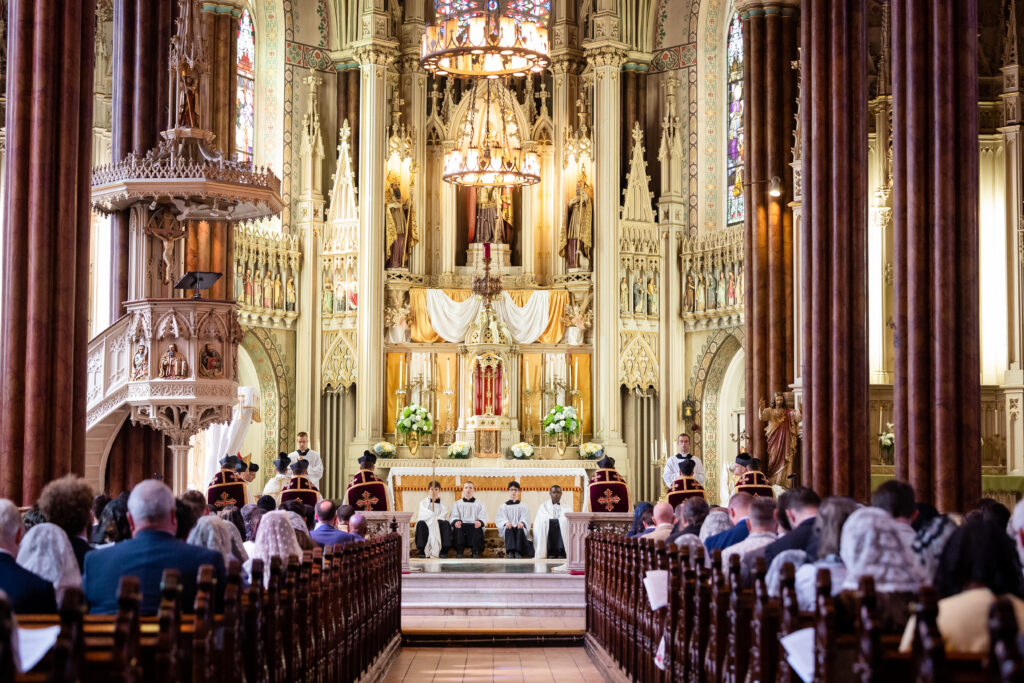
I confess that the significance of May 21st eluded me until an astute parishioner reminded me of its importance. Last year, after Traditionis Custodes, the Fraternity asked all of our priests and parishioners to pray as we tried to navigate our way through these uncertain waters. Here at the Shrine, we took that call seriously. We engaged a 54-Day Rosary Novena, and prayed other Novenas and devotions; it all culminated with the Consecration to the Blessed Virgin on the Feast of Lourdes.
On that day of Consecration, we received word of our exemption from Pope Francis, and soon afterwards, I told my parishioners that I had personally entrusted the Shrine and the Fraternity to Saint Therese in my own novenas. I promised her that in gratitude for her intercession, I would celebrate a Mass in her honor with at least 500 roses on the altar. That Mass, with over 1500 roses, had been celebrated exactly one year prior, 21 May 2022.
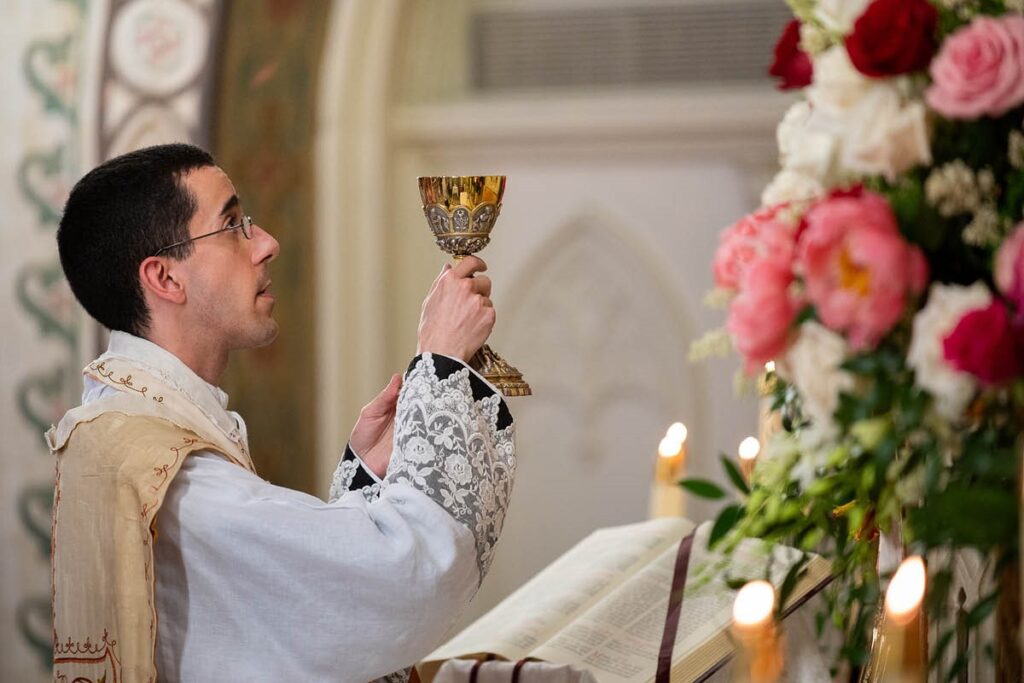
Throughout my time here at the Shrine, one thing that has been consistent in my own exhortations to my parishioners is the importance of prayer, our firm reliance upon it, and our firm trust in Almighty God. I had no dates in mind for Vespers, but Saint Therese did, and so did Divine Providence.
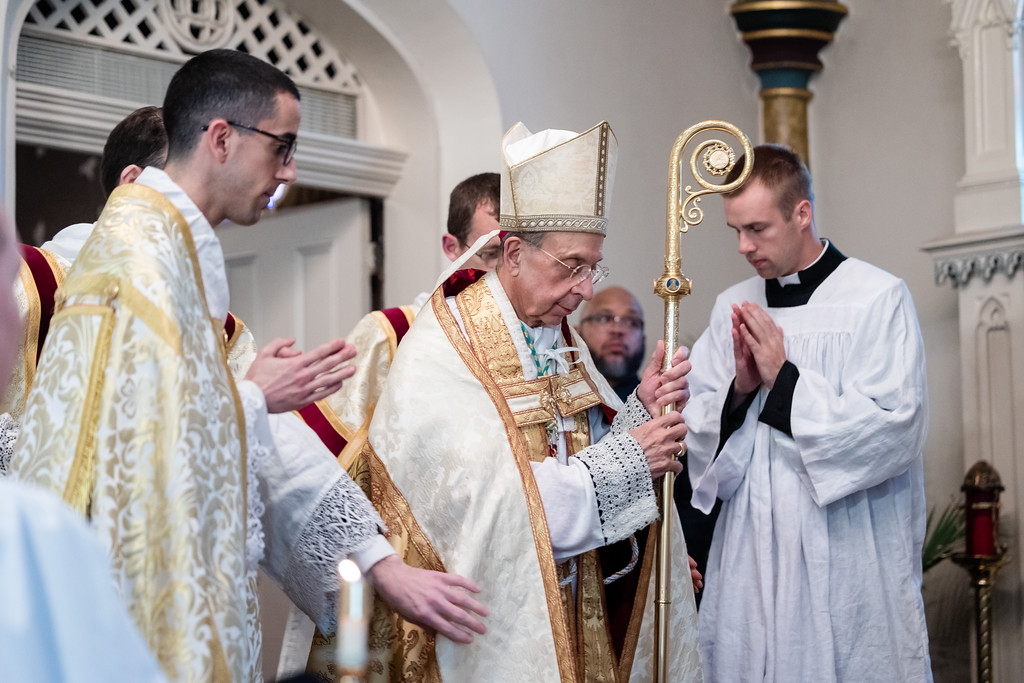
It is nothing other than a gentle, but clear reminder to us that our good God continues in His steadfast fidelity to us; a reminder yet again, that when all looks uncertain and lost, we may yet look to Him with confidence and without fear. The occasion of His Excellency’s visit on the anniversary of our Mass of Roses reminds us that our fidelity to Christ and His Church is not unnoticed by Him.
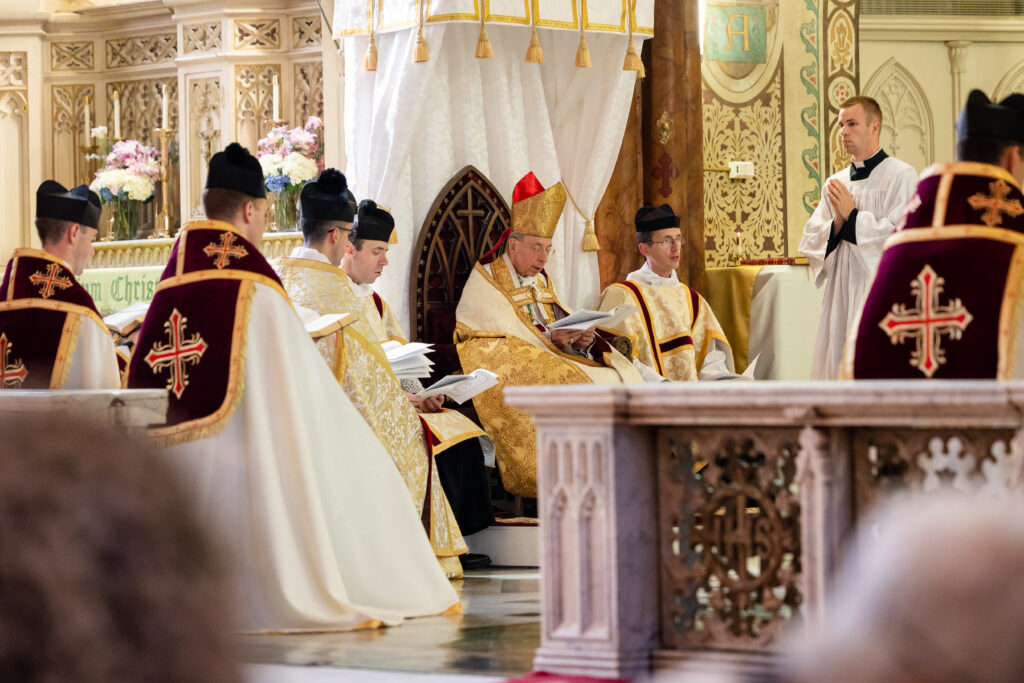
In that same vein, I wish to make one further remark about the day’s Vespers. Our parishioners saw in the sanctuary, that afternoon, the dignity of the Office of Bishop on full display, as we recognized in him a successor of the Apostles, our link back to Christ. We are his faithful children because we are faithful children of the Church, and it is precisely this fidelity that is so integral to our Priestly Fraternity and which continues to be a source of grace and blessing to us today.
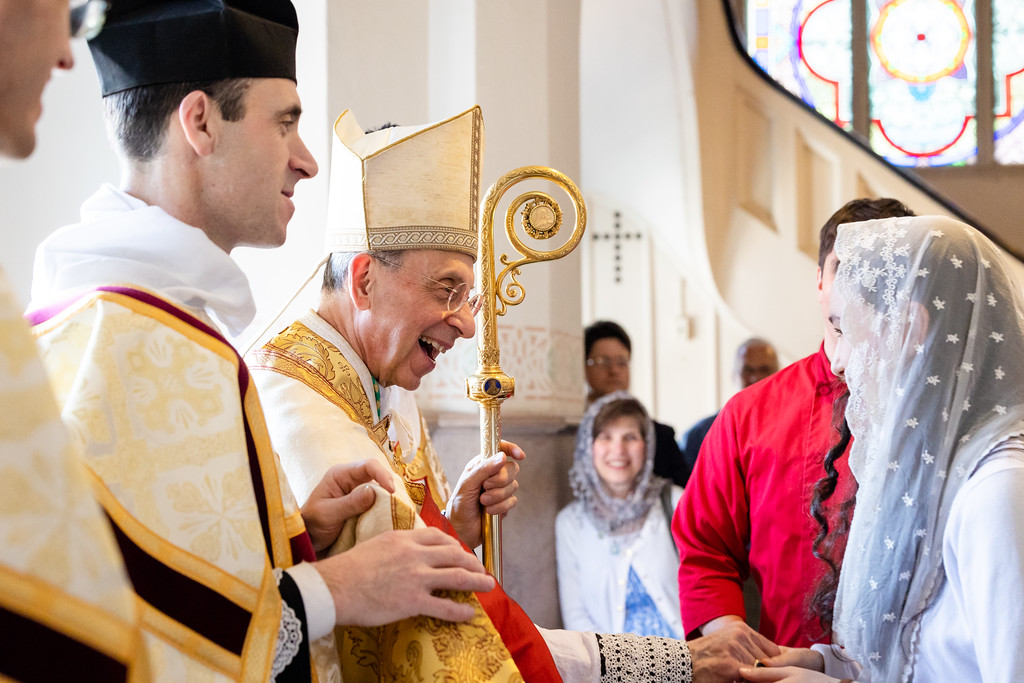
May we continue to entrust ourselves to our good God who is faithful to us beyond measure. May we pray for His Excellency and our Archdiocese and the Priestly Fraternity of Saint Peter. May we grow in fidelity to Christ and His Church, remembering the words of our Blessed Savior, “Fiat voluntas Tua.” Thy will be done.
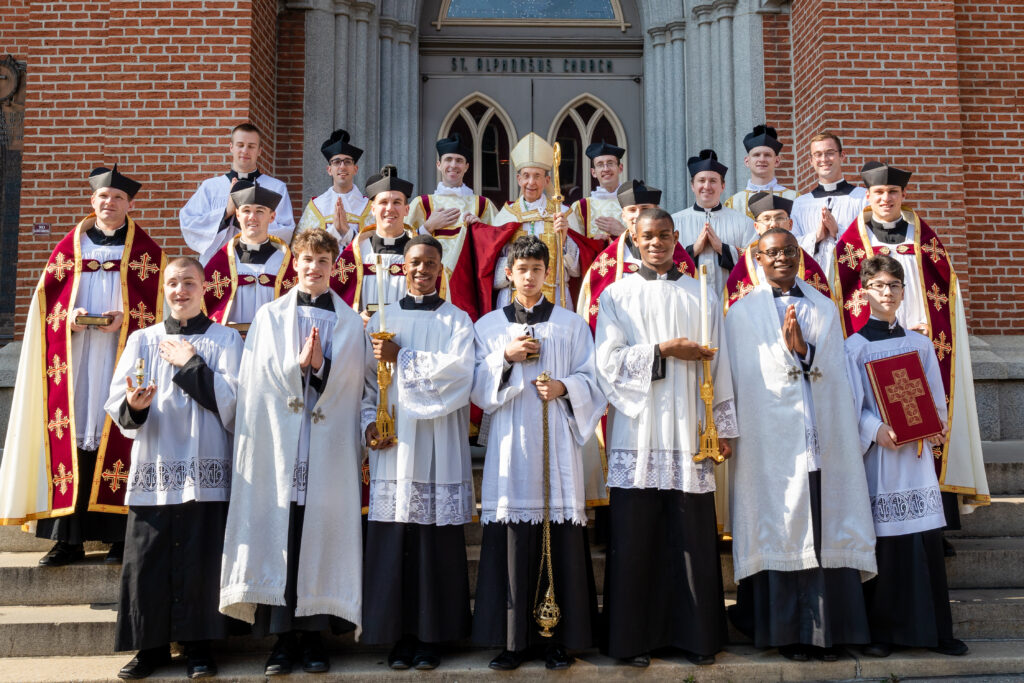
May 26, 2023

Our Lady, Queen of Apostles
by Fr. William Rock, FSSP
In the traditional Roman Missal, there is a section near the back which contains Masses for “Particular Places.” Associated with feasts in their “Particular Places,” these Masses can also be freely prayed as votive Masses of the 4th class.1 One of these Masses is the Mass of “Our Lady, Queen of Apostles,” which is assigned to the Saturday following the Feast of the Ascension. This Mass can be seen as marking the days between the Ascension of Our Lord and the sending of the Holy Ghost at Pentecost, when, having returned to Jerusalem and the Upper Room where the Last Supper was celebrated, the Apostles and Disciples “were persevering with one mind in prayer with the women, and Mary the mother of Jesus, and with his brethren,” as it says in the Epistle for this Mass (Act 1:1-14). These nine days of preparation, which the Apostles and Disciples kept with Our Lady, was the first novena.
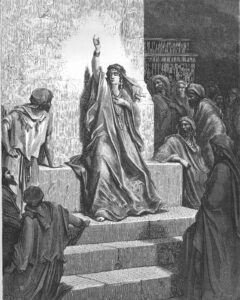
The Offertory Chant for this Mass of “Our Lady, Queen of Apostles” draws from the Book of Judges (5:3, 7-8). After the Hebrews, under the command of Josue, conquered the Promised Land and divided it by lot between the Tribes, there was not a centralized government, and there was not yet a king over Israel. Instead, the Tribes were to govern themselves following the Laws which God had given them at Mount Sinai. God Himself was to be the King of the Hebrews, and He would appoint certain chosen individuals to serve as judges over Israel in His stead and in His Name. These judges were usually military leaders for, if the Hebrews were unfaithful and worshiped the strange gods of those peoples of the Land whom they should have destroyed or driven from the Land, these peoples would subject the Hebrews to their rule, oppressing them. Worship strange gods and become subject to the people of those gods. When the Hebrews repented, God would raise up a Judge to deliver them from their oppressors.
At a time when the “children of Israel again did evil in the sight of the Lord…the Lord delivered them up into the hands of Jabin, king of Chanaan, who reigned in Asor: and he had a general of his army named Sisara,” (Jdg 4:1-2) there was “Debbora, a prophetess, the wife of Lapidoth, who judged the people” (Jdg 4:4). God, at this time, chose a woman, a prophetess, to rule His people. The Lord God commanded Barac, through Debbora, to lead an army against their oppressors. When Barac protested that he would only go into battle if Debbora went with him, she prophesied that “I will go, indeed, with thee, but at this time the victory shall not be attributed to thee, because Sisara shall be delivered into the hand of a woman” (Jdg 4:9). And this came to pass for the general Sisara was killed by a woman, Jahel. While he was hiding in her tent sleeping, Jahel hammered a tent stake through his temple (Jdg 4:21).
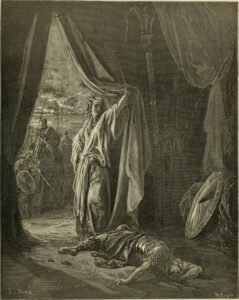
After the military victory, Debbora sang an inspired song. The Church draws from this song for the aforementioned Offertory Chant for the Mass of “Our Lady, Queen of Apostles:” “It is I, it is I who [quae] will sing to the Lord the God of Israel. The valiant men ceased and rested in Israel until a mother arose in Israel. The Lord chose new wars, and He Himself overthrew the gates of the enemies.”2 In the Latin, it is clear that it is a woman who is singing this song. In the historical context, it is Debbora who is singing. She sings of the warriors of Israel who did not engage with their enemies, who “ceased and rested,” until “a mother arose in Israel,” that is Debbora herself who rallied the troops and went with them into battle. They were victorious over their oppressors because it was the Lord Who called them to battle and Who was with them.
Figuratively, it is the Blessed Virgin Mary who sings these lines; she is the Mother who arose in Israel. For Debbora is a type, a prefiguring, or a foreshadowing of the Blessed Virgin Mary. Debbora was a mother in the Old Israel, and Mary is the Mother of the New Israel. Mary and Debbora are both prophetesses – “for behold from henceforth all generations shall call me blessed” (Luk 1:48). Debbora judged, that is, ruled over the Old Israel. The Blessed Virgin is the Queen Mother of the New Israel. Debbora lent her support in a military campaign, the Blessed Virgin supports her subjects, her children, in their battles against their enemies, the world, the flesh, and the devil.

The valiant men can be seen as representing the Apostles, who “rested” in prayer with Our Lady, their common Mother, during these nine days of the Novena between the Ascension and Pentecost and then rose up and entered into the battle of founding and propagating the Church under the maternal gaze of Our Lady. For the Apostles were strengthened by the coming of the Holy Ghost so that they might “faithfully serve God’s Majesty and propagate by word and example the glory of His Name,” as the Church requests on behalf of her children in the Collect (opening prayer) of the Mass of “Our Lady, Queen of the Apostles.” For God Himself “overthrew the gates of the enemies” by the Passion, Death, and Resurrection of His Son.
The other woman mentioned, Jahel, who killed the enemy general by a blow to the head, can also be seen as a type of Mary. When enemies receive death at the hand of a woman in the Old Testament, the death comes from a blow to the head, for all of these valiant women, including Jahel, are types, foreshadowings of the Woman predicted in Genesis who will crush the head of the ancient serpent (Gen 3:15) – the Blessed Virgin Mary. Additionally, when Debbora was singing her prophetic victory song, which the Offertory quotes, she sings “blessed among women be Jahel.” Such a phrase was echoed by the Archangel Gabriel and St. Elizabeth when they said to the Blessed Virgin “blessed art thou among women” (Luke 1:28, Luke 1:42)
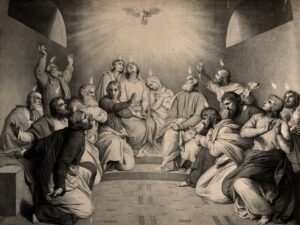
In the Communion Chant, the Church sings the following: “Blessed Mother and Immaculate Virgin, glorious Queen of the world, intercede for us before the Lord: for thou art the glory of Jerusalem, the joy of Israel, the honor of our people.” The closing words of this chant – “thou art the glory of Jerusalem, the joy of Israel, the honor of our people” – are taken from the praise given to Judith by the people after she delivered them from an enemy by killing their general by blows to his head (Jdt 15:10). Just like Jahel, Judith is also seen as a type of Our Lady – the heroine who strikes at the head of the enemy and saves her people.3
All of this should give us great confidence in Our Blessed Lady, for as great as were these heroines of old, so much greater is she whom they represent. Let us then, in these days leading up to the feast of Pentecost, imitating the Apostles, keep close to Our Lady in our prayers – indeed even by having this Mass prayed during the Novena when possible – so that we might be well-disposed to receive the gifts which God wishes to give us on this upcoming Feast of Pentecost. Then may we, like the Apostles, “faithfully serve God’s Majesty and propagate by word and example the glory of His Name.”
May Our Lady, the true Debbora, the true Jahel, and the true Judith, pray for us!
William Rock, FSSP was ordained in the fall of 2019 and is currently assigned to Regina Caeli Parish in Houston, TX.
- Additionally, according to the decree Cum sanctissima (n. 6), these Masses for “Particular Places” can be freely commemorated on their assigned days in the Masses (and Offices) of 3rd and 4th class days outside of their “Particular Places.”
- The translations of the Mass propers are taken from the Angelus Press 1962 Hand Missal.
- More information about types of Our Lady, including Debbora (Deborah), Jahel (Jael), and Judith, can be found here.
May 19, 2023

OLGS Rogations Photopost
Today we find ourselves in Rogationtide again this year, a day of penance and prayer to ask God’s favor (Latin rogare, to ask). There are actually two separate Rogations that share the same name and liturgy, but are of somewhat different origin.
The Greater Rogations always fall on the feast of St. Mark, April 25th, and are the more ancient observance. They are believed to have been introduced in Rome specially to counteract the Robigalia, a pagan festival and procession whereby a dog was sacrificed to the god Robigo to protect the grain from disease.
The Lesser Rogations, which always fall on the Monday, Tuesday, and Wednesday before Ascension, were instituted by St. Mamertus of Vienne in the 5th century, and spread from Gaul to Rome around the beginning of the 9th century.
The Rogations emphasize, first and foremost, the need to turn to God in prayer and boldly ask Him for our needs. The Gospel and the Communion verse of the Mass both feature Christ’s famous words from the 11th chapter of Luke:
Ask, and it shall be given you; seek, and you shall find; knock, and it shall be opened to you. For every one that asketh, receiveth, and he that seeketh, findeth, and to him that knocketh it shall be opened.”
And in a nod to the feast’s origins, that asking is seen in a specifically agricultural context in the Mass’s Epistle, of St. James:
Elias was a man passible like unto us; and with prayer he prayed that it might not rain upon the earth, and it rained not for three years and six months: and he prayed again, and the heaven gave rain, and the earth brought forth her fruit.
Now that more of the faithful are employed in factory and office work than in farm work, the agricultural importance of the Rogations has unfortunately been made less relevant.
But there are certainly still places where the tradition is kept up, including at our very own Our Lady of Guadalupe seminary. We are pleased to pass along some photos from the April 25th OLGS Rogation Mass and Procession, which included a blessing of the orchard and garden. More images can be found on the OLGS site here.
May 15, 2023

Father Terrence Gordon, FSSP+ Obituary
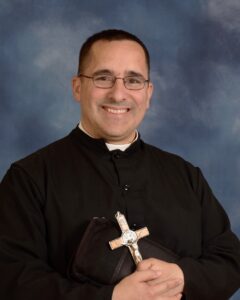 Fr. Terrence Patrick Gordon was born on March 17, 1971, son of Beatrice Tena and James Patrick Gordon. He was baptized at Sacred Heart of Jesus Church in his native Nogales, Arizona.
Fr. Terrence Patrick Gordon was born on March 17, 1971, son of Beatrice Tena and James Patrick Gordon. He was baptized at Sacred Heart of Jesus Church in his native Nogales, Arizona.
Before entering the Seminary, Fr. Gordon received his bachelor’s degree in computer science from the US Naval Academy in Annapolis, Maryland. He served in the United States Marine Corps as an officer, reaching the rank of Captain. He was stationed in Okinawa, Japan for over a year as a Platoon Commander.
Fr. Terrence Gordon entered Our Lady of Guadalupe Seminary of the Priestly Fraternity of St. Peter in 1999. He was permanently incorporated into the FSSP on April 08, 2005, and ordained a deacon the next day on April 9, 2005.
He received the sacred order of Priesthood from the hands of His Excellency Fabian Bruskewitz, then bishop of Lincoln, Nebraska, on June 3, 2006. His older brother James was ordained in 2004 and his younger brother Dennis in 2008.
Father’s first assignment was as assistant chaplain at the Fraternity’s apostolate, St. John the Baptist, in North Little Rock. He had previously served there as a deacon. Father Gordon became chaplain in 2007. In 2009 he was transferred to Omaha, Nebraska where he served as parochial vicar at Immaculate Conception Church until 2013. He was then transferred to Irving, TX. He served at Mater Dei Church in Texas until 2016.
Father served as parochial vicar of St. Joseph’s Parish in North Chesterfield, VA from 2016 until 2019 and in June of 2019, he was assigned to Immaculate Conception Parish in Colorado Springs, serving as parochial vicar with his brother, Fr. James Gordon, FSSP.
Fr. Terrence Gordon’s time in Colorado was interrupted for several months as he discerned a possible vocation to the more contemplative religious life. Father returned to Colorado Springs in 2021. Father Gordon was known for his love of the Catholic Faith, his zeal, and his deep devotion to the Blessed Virgin Mary.
In the evening of April 28th, 2023, Father Terrence Gordon died of an unexpected heart attack. In his last moments, he was assisted by his brother Fr. James Gordon, FSSP who gave him the last rites. The funeral arrangements for Fr. Terrence Gordon are as follows:
May 8th at St. Mary’s Cathedral in Colorado Springs, Colorado:
❖ 9 am viewing and rosary at St. Mary’s Cathedral in Colorado Springs
❖ 10 am Requiem Mass with the body present
May 11th at Immaculate Conception in Omaha, Nebraska:
❖ 1 pm viewing and rosary.
❖ 2 pm Requiem Mass of Burial
❖ The rite of burial will follow the Mass at Immaculate Conception and will take place at the Cemetery of Our Lady of Guadalupe Seminary, Denton Nebraska.
Eternal rest grant unto him, O Lord, and let perpetual light shine upon him. + May his soul and all the souls of the faithful departed, rest in peace. Amen. +
For a PDF version, click here.
May 4, 2023

Requiescat in Pace: Fr. Terrence Gordon, FSSP
 The North American Province of the Priestly Fraternity of St. Peter is grieved over the loss of one of our confreres, Fr. Terrence Gordon, FSSP, who passed away on Friday April 28th. Fr. Gordon was ordained on June 3, 2006 and was assigned as assistant Pastor at Immaculate Conception in Colorado Springs.
The North American Province of the Priestly Fraternity of St. Peter is grieved over the loss of one of our confreres, Fr. Terrence Gordon, FSSP, who passed away on Friday April 28th. Fr. Gordon was ordained on June 3, 2006 and was assigned as assistant Pastor at Immaculate Conception in Colorado Springs.
We will post the details of funeral arrangements as these become available. In the meantime, we ask for prayers for the repose of his soul as well as for his parish and his family, especially for his brothers Fr. Dennis Gordon, FSSP and Fr. James Gordon, FSSP who was stationed with him in Colorado Springs and administered Last Rites.
Eternal rest grant unto him, O Lord, and may the perpetual light shine upon him.
April 29, 2023

The Times of Mass
by Fr. William Rock, FSSP
“What time is Mass?” is a question heard frequently enough in Catholic households. Such a question is reasonable as each parish will have its own Mass schedule, taking into consideration the work schedule of the parishioners, the local traffic conditions at different times of the day, and other such factors. There seems to be no set time for Mass to be celebrated, and some surprise is even experienced when “At midnight,” is answered to the question “What time is the Christmas Midnight Mass?”
Previously, however, the situation, particularly that of the ancient Papal Station Masses1 and of the conventual (i.e. the community) Masses of monastic communities, was different. Here, depending on what the day was on the Church’s liturgical calendar, the Mass would occur at different times of the day. St. Thomas Aquinas captured this ancient tradition in his Summa Theologica. But, in order to understand what he wrote, one must understand how the ancient Romans would have kept time. For the ancient Roman, there would be 12 hours of daylight, regardless of how much daylight there might be on a given day. As a result, an “hour” would vary in length depending on how much daylight a given day would have. Based on this system, the Third Hour (Terce) marked when the sun was halfway up to its zenith, the Sixth Hour (Sext) marked when the sun reached its zenith, and the Ninth Hour (None) marked when the sun was halfway down from its zenith. In some explanations, the Third Hour is associated with our 9 am, the Sixth Hour with 12 noon, and the Ninth Hour with 3 pm, but these are approximations. The names of these Hours were adopted as the names of portions of the daily cycle of prayers of the Divine Office which are associated with each particular time of day.2 With this explanation, St. Thomas’s text can be presented (S.T. III, q. 83, a. 2, ad. 3).

As already observed (III:73:5), Christ wished to give this Sacrament [the Eucharist] last of all, in order that it might make a deeper impression on the hearts of the disciples; and therefore it was after supper, at the close of day, that He consecrated this Sacrament and gave it to His disciples. But we celebrate [Mass] at the hour when our Lord suffered, i.e. either, as on feast-days, at the hour of Terce, when He was crucified by the tongues of the Jews (Mark 15:25), and when the Holy Ghost descended upon the disciples (Acts 2:15); or, as when no feast is kept, at the hour of Sext, when He was crucified at the hands of the soldiers (John 19:14), or, as on fasting days, at None, when crying out with a loud voice He gave up the ghost (Matthew 27:46-50).
Nevertheless the Mass can be postponed, especially when Holy Orders have to be conferred, and still more on Holy Saturday; both on account of the length of the office, and also because Orders belong to the Sunday, as is set forth in the Decretals (dist. 75).
Masses, however, can be celebrated “in the first part of the day,” owing to any necessity; as is stated De Consecr., dist. 1.
The same tradition is expressed by William Durandus the Elder, Bishop of Mende (d. A.D. 1296), the great medieval liturgical commentator, in his Rationale Divinorum Officium (see IV, I, 20-21). He also adds that:
However, on the day of the Lord’s Nativity a Mass is sung at night, as already noted under that feast. And then if two Offices occur on the same day during Lent – which we call “double days” – the Mass for the feast is said at the third hour, without genuflection, and the daily office for Lent at the ninth hour, with genuflection. During the season of Advent, the Mass for a Saint’s feast is celebrated at the third hour.3
This practice of having more than one Mass per day is also noted by St. Thomas: “Likewise on other days upon which many of God’s benefits have to be recalled or besought, several Masses are celebrated on one day, as for instance, one for the feast, and another for a fast or for the dead” (S.T. III, q. 83, a. 2, ad. 2).
On feast days, Mass would be said mid-morning, and, on non-feast, non-fasting days, Mass would be said around noon. On fasting days, Mass would be said midafternoon, after which the Romans would break their fast, which at the time meant no eating at all before this point.4 Yet regardless of the time Mass was celebrated, a connection was made with Our Lord’s suffering and death. Time is sacred and sanctified. Not just days and seasons, but even the different hours of the day.
St. Thomas, in the above, noted that on Ember Saturdays and on Holy Saturday,5 when ordinations would have historically been conducted, the Liturgy could be postponed from None because Holy Orders belong to Sunday. As an authority for this position, he referenced the Decretals of Gratian, the contemporary collection of Canon Law. The entry referenced by St. Thomas in the Decretals is itself a portion of the Letter of Pope St. Leo the Great (reigned A.D. 440-61) to Dioscorus, Bishop of Alexandria. The pertinent part of the Letter is given here:
That therefore which we know to have been very carefully observed by our fathers, we wish kept by you also, viz. that the ordination of priests or deacons should not be performed at random on any day: but after Saturday, the commencement of that night which precedes the dawn of the first day of the week should be chosen on which the sacred benediction should be bestowed on those who are to be consecrated, ordainer and ordained alike fasting. This observance will not be violated, if actually on the morning of the Lord’s day it be celebrated without breaking the Saturday fast: for the beginning of the preceding night forms part of that period, and undoubtedly belongs to the day of resurrection as is clearly laid down with regard to the feast of Easter. For besides the weight of custom which we know rests upon the Apostles’ teaching, Holy Writ also makes this clear, because when the Apostles sent Paul and Barnabas at the bidding of the Holy Ghost to preach the gospel to the nations, they laid hands on them fasting and praying: that we may know with what devoutness both giver and receiver must be on their guard lest so blessed a sacrament should seem to be carelessly performed. And therefore you will piously and laudably follow Apostolic precedents if you yourself also maintain this form of ordaining priests throughout the churches over which the Lord has called you to preside: viz. that those who are to be consecrated should never receive the blessing except on the day of the Lord’s resurrection, which is commonly held to begin on the evening of Saturday, and which has been so often hallowed in the mysterious dispensations of God that all the more notable institutions of the Lord were accomplished on that high day. On it the world took its beginning. On it through the resurrection of Christ death received its destruction, and life its commencement. On it the apostles take from the Lord’s hands the trumpet of the gospel which is to be preached to all nations, and receive the sacrament of regeneration which they are to bear to the whole world. On it, as blessed John the Evangelist bears witness when all the disciples were gathered together in one place, and when, the doors being shut, the Lord entered to them, He breathed on them and said: Receive the Holy Ghost: whose sins you have remitted they are remitted to them: and whose you have retained, they shall be retained [Joh 20:22-23]. On it lastly the Holy Spirit that had been promised to the Apostles by the Lord came: and so we know it to have been suggested and handed down by a kind of heavenly rule, that on that day we ought to celebrate the mysteries of the blessing of priests on which all these gracious gifts were conferred.
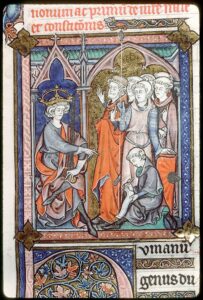
Liturgical scholars of the 1800s and 1900s, such as Servant of God Dom Prosper Guéranger6 and Blessed Ildefonso Schuster,7 Archbishop of Milan, when reconstructing the Ember Saturday Ordination Liturgies, stated that the Ember Saturday Ordination Masses began late Saturday, with the ordinations occurring on Sunday itself, around dawn. Similar conclusions were made about the Easter Vigil.8 More recent scholars, however, such as Mr. Gregory DiPippo (see, for example, here, and here) have argued that this reconstruction is flawed and that these ceremonies, even starting late Saturday, would have concluded well before the midnight between Saturday and Sunday. This position, expressed by Mr. DiPippo, more closely matches with the explanation given by Pope St. Leo. In fact, in his Letter, Pope St. Leo had to explain that it is possible for ordinations to occur on the Sunday itself, so long as the fasting from Saturday has not been broken. If ordinations regularly occurred on the Sunday itself, such an explanation would be superfluous. The misunderstanding of earlier liturgical scholars no doubt contributed to the rubric promulgated under Venerable Pope Pius XII that things were to be so timed that the Mass of the Easter Vigil was to start at or around midnight.
All this having been said, what did St. Thomas mean when he noted that the Masses of the Ember Saturdays and of the Vigil of Easter, could be postponed from None? He simply meant that the Liturgy could start at such a time that it would be closer to sundown on Saturday so that the ordinations would be conferred around or after sunset, for, as St. Leo wrote, “the day of the Lord’s resurrection…is commonly held to begin on the evening of Saturday.” This assertion should not be unexpected as the Christian tradition is that feasts, particularly Sundays, start the evening before. In his Commentary on the Gospel of St. John, St. Thomas, expressing this tradition, wrote:
To elucidate this it should be noted that, the feasts of the Jews began on the evening of the preceding day (Lev 23:5). The reason for this was that they reckoned their days according to the moon, which first appears in the evening; so, they counted their days from one sunset to the next. Thus for them, the Passover began on the evening of the preceding day and ended on the evening of the day of the Passover. We celebrate feasts in the same way…(cap. 13, lect. 1, n. 1730)
Many who pray the Divine Office are used to normal feasts starting with the night office of Matins and concluding, in the evening of the day of the feast, with Vespers and Compline. Feasts of greater rank, however, start the evening before, with the Offices of Vespers and Compline. So major feasts have a first and second Vespers, while those of lesser rank only have one Vespers, which would correspond to second Vespers. But, before the reforms of the mid-twentieth century, the situation was reversed. All feasts would have had first Vespers, while only major feasts would have a second Vespers. In this way, Christian feasts would start the evening before, continuing the ancient tradition expressed by Pope St. Leo and St. Thomas.
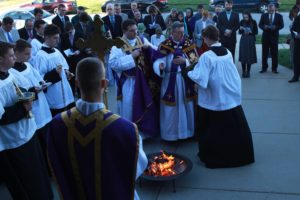
This practice may also explain why, in the traditional Easter and Pentecost Vigils, the color changes from Violet to White or Red respectively for the Mass. The Violet expressed that these Saturdays are days of fasting,9 but, once the sun has set, the color changes to mark that, while the Masses are still those of the Vigils, not of the Feasts themselves, they do partake the festal character of the approaching Feasts. Properly, the beginning of these Feasts is their First Vespers, which, in the case of Easter, is incorporated into the traditional Vigil Mass itself.
Traces of the tradition regarding Mass times perdured even into the 20th century. In pre-1962 Missals, the following rubrics are found:
1. Private Masses are able to be said at any hour from dawn to noon, with at least Matins and Lauds having been prayed. [This is in keeping with what St. Thomas said about Masses being said “‘in the first part of the day,’ owing to any necessity.”]
2. Conventual and Solemn Masses, however, ought to be said according to the following order. On Feasts of Double and Semidouble rank, on Sundays, and within Octaves, after the Hour of Terce has been prayed in choir. On Feasts of Simple rank, and on ferias [days with no feasts] throughout the year, after the Hour of Sext [has been prayed in choir]. In Advent, Lent, and on the Ember Days (even within the Octave of Pentecost), and on fasting Vigils, although the days are solemn, the Mass of these times ought to be sung after the Hour of None [has been prayed in choir] (Missale Romanum [1920], Rubricæ generales Missalis, XV — De Hora celebrandi Missam).
Here is preserved the times and distinctions noted by St. Thomas and Durandus. Conventual and Solemn Masses on feast days (feasts of Double and Semidouble rank) would be said mid-morning, and, on non-feast, non-fasting days (feasts of Simple rank and ferias), Mass would be said around noon. On fasting days (Advent, Lent, Ember Days, and fasting Vigils), Mass would be said midafternoon.
It should be noted that in the above rubrics, “Vigil” means a day of proximate preparation immediately preceding a feast and the Vigil Mass is the Mass proper of this preparatory day. This must be distinguished from a Mass celebrated in the evening before a feast day which is liturgically the Mass of the feast. Properly speaking, such a Mass is an anticipated Mass, not a Vigil Mass. An example of a proper Vigil Mass is the Mass of December 24th, which is the Vigil Day of the Nativity of Our Lord.
In addition to the information provided in the above quoted rubrics, the proper instructions given for Ash Wednesday, the Easter Vigil,10 and the Pentecost Vigil in such Missals contain the rubrics that the ceremonies should start after the Office of None has been prayed, indicating they are celebrated on penitential days. For the Feast of the Annunciation, which usually falls during Lent, instructions are given that the Mass is to start after the Office of Terce has been prayed, as it is a feast day.
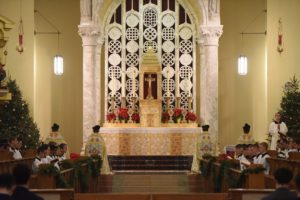
For the sake of completion, it is worth noting that there are two Masses which do not follow the Terce-Sext-None pattern, namely the First and Second Masses of Christmas. The First Mass of Christmas, the Midnight Mass – which is not the Vigil Mass of the Nativity; the Vigil Mass of the Nativity, referenced above, is said after None on December 24th, or after Terce if this day falls on a Sunday – is said following Matins around midnight for Christ “was literally born during the night, as a sign that He came to the darknesses of our infirmity; hence also in the Midnight Mass we say the Gospel of Christ’s nativity in the flesh” (S.T. III, q. 83, a. 2, ad. 2). The Second Mass of Christmas, the Dawn Mass, is said after Lauds and Prime (the First Hour), for there is a “spiritual birth, whereby Christ rises ‘as the day-star in our hearts’ (2 Peter 1:19), and on this account the Mass is sung at dawn” (ibid.). It is the Third Mass of Christmas, the Day Mass, which is celebrated after Terce, which is most properly the Mass of this Feast.11
In addition to all this, St. Thomas and Durandus noted that during Lent there are “double days,” when two Masses are said. In pre-1962 Missals, after the entry for February 4th in the Proper of the Saints, a lengthy rubric is given on how to proceed during Lent. A portion of this rubric translates as:
Where, however, there is the choral obligation [such as with monks], the Mass of the Feast [of Double or Semidouble Rank] is read extra Chorum, without a Commemoration of the Lenten feria, after the Hour of Terce has been prayed; the conventual Mass of the Feria is said in Choro, without a commemoration of the Feast, after the Hour of None has been prayed…If, however, the feast is a Double of the First or Second Class, the conventual Mass of the Feast is said in Choro, and the Mass of the Feria is read extra Chorum. Private Masses, however, of the Mass of the Feria are prohibited.
Here we see the practice described by St. Thomas and Durandus was still kept where there was a choral obligation, such as in monasteries. When a feast falls during Lent, two Masses would be said – the Mass of the feast in the morning and the Mass of the Lenten feria in the afternoon.
So then, dear reader, the next time you find yourself at Mass, try to identify what type of day it is on the liturgical calendar – a feast day, a non-feast/non-fast day, or a fasting day – and unite yourself to the portion of Our Lord’s Passion associated with the hour at which this Mass would have been said. And thus, you will be joining yourself in spirit with those Roman Christians of so long ago and those religious who, even up to today, still observe the practice of celebrating Mass after Terce, Sext, or None as the case may be. And the next time someone asks “What time is Mass?,” please be sure to share this article.
William Rock, FSSP was ordained in the fall of 2019 and is currently assigned to Regina Caeli Parish in Houston, TX. Special thanks are due to Fr. James Smith, FSSP, for his support and encouragement.
- On certain days of the Liturgical Year, the Pope would celebrate the primary Mass for the city of Rome at one of the various churches of the city. The church where this would take place was called the Station.
- The Divine Office is a collection of Psalms, Hymns, and Prayers which are assigned for each day, which are then in turn divided into different “Hours” which historically correspond with different times of the day.
- Durand, William. Rationale IV – On the Mass and Each Action Pertaining to It. Trans. Thibodeau, Timothy M. (Turnhour: Crepols Publishers n.v., 2013), p. 61 (IV, I, 21). Here Durandus seems to be making a distinction between days with penitential kneeling and days without it, a distinction still maintained today. On fasting days or during Masses of a more somber character, those attending Mass kneel for the Collect(s) (opening prayer), from the Sanctus until Communion, standing at the Agnus Dei and Pax, and for the Postcommunion(s) (closing prayer) (“with genuflection”). In the Divine Office, those attending would also kneel for the closing oration(s). On other days, those attending Mass would only kneel for the Consecration and Communion out of reverence (“without genuflection”). As the penitential kneeling would never occur on Sundays, but only reverential kneeling, the 20th Canon of Nicaea I is still observed.
- Schuster, Ildefonso. The Sacramentary, vol. II (Parts 3 & 4). Trans. Levelis-Marke, Arthur. (Waterloo: Arouca Press, 2020), p. 39. For more information about the historical daily breaking of the Lenten Fast, see Mr. Gregory DiPippo’s article here. While reading his article, please note that according to Blessed Schuster, “Vespers did not form part of the Roman cursus until the seventh century” (vol. II, p. 251). This being the case, before Vespers was introduced, the daily Lenten Fast would have been broken immediately following Mass.
- In addition to the Ember Saturdays and Holy Saturday, the Pontificale Romanum [1752 and 1961-1962 editions] also indicates the Saturday before Passion Sunday as a day of Ordination. The rubric reads: “Tempora ordinationum sunt: sabbata in omnibus Quatuor Temporibus, sabbatum ante dominicam de Passione et Sabbatum sanctum.”
- Guéranger, Prosper. The Liturgical Year, 5 (Lent). Trans. Shepherd, Laurence. (Fitzwilliam: Loreto Publications, 2000), p. 179.
- Schuster, pp. 5, 73-74, 141; also Schuster, Ildefonso. The Sacramentary, vol. IV (Parts 7 & 8). Trans. Levelis-Marke, Arthur. (Waterloo: Arouca Press, 2020), p. 18.
- See, for example, Schuster, vol II, p. 29.
- In the 1917 Code of Canon Law, the Vigil of Pentecost was listed as a day of fasting and abstinence (Canon 1252, 2).
- Additionally, another entry in the Decretals indicate that the Mass of the Holy Saturday is to start around the beginning of the night: “In ieiuniis etiam quatuor temporum circa uespertinas horas, in sabbato uero sancto circa noctis inicium missarum solempnia sunt celebranda.”
- That the Day Mass of Christmas is the historic Mass proper to the Nativity of the Lord can also be deduced from evaluating the Stations of each Mass. The Station for the Midnight Mass is St. Mary’s at the Crib, which is a Chapel in St. Mary Major. According to Blessed Schuster “if we are to judge of the number of worshippers by the size of the place in which the station was celebrated, we must conclude that the little crypt ad praesepe [at the crib] would accommodate but very few persons.” As such, this chapel could not accommodate the great concourse of Romans who would be expected to be in attendance on a day of such importance. The Second Mass, the Dawn Mass, is celebrated at the Church of St. Anastasia. Originally, according to Blessed Schuster, this was not a Mass of Christmas but of the Saint herself, as this day was the anniversary of her martyrdom. Only later did the Mass become one of Christmas, with the Martyr commemorated, as is still observed today. It is only the Third Mass, then, held at the Vatican at St. Peter’s which can truly be considered the historical solemn Mass of Christmas.
April 10, 2023


